Monthly Archives: June 2016
The Wisconsin Trip: Searching for Two Endangered Species
The more you are around different birders, the more enlightened you become about various opportunities not far from home. Thanks to a birding friend, who shall rename nameless in this post, I learned that it was possible to see both Whooping Cranes and Kirtland’s Warblers just 5 hours and change from my house in next door Wisconsin. I’ll explain more at the end of the post why I’m keeping my friend anonymous, but he or she knows who he/she is. And that he/she is pretty awesome. 🙂
So on June 12th, Evan, Tommy, and I embarked on an overnight trip to central Wisconsin to go after these two birds which would obviously be lifers for all of us. Our first destination in Wisconsin was Necedah National Wildlife Refuge to look for the Whooping Crane. Whooping Cranes can be found in several places in Wisconsin, but we were told Necedah had good numbers, therefore making it the best spot to try. By good numbers, I’m talking about no more than a dozen birds as there are only 300+ Whoopers in the world today.
As we drove through forests upon entering Necedah, we were somewhat baffled that Cranes live here. However, almost immediately we spied a road that seemed to go toward an open, marshy area. So we took it. A minute later, I spotted the first Whooping Crane for our group. Cool! It was pretty far out, but even still we could see just how massive it was.
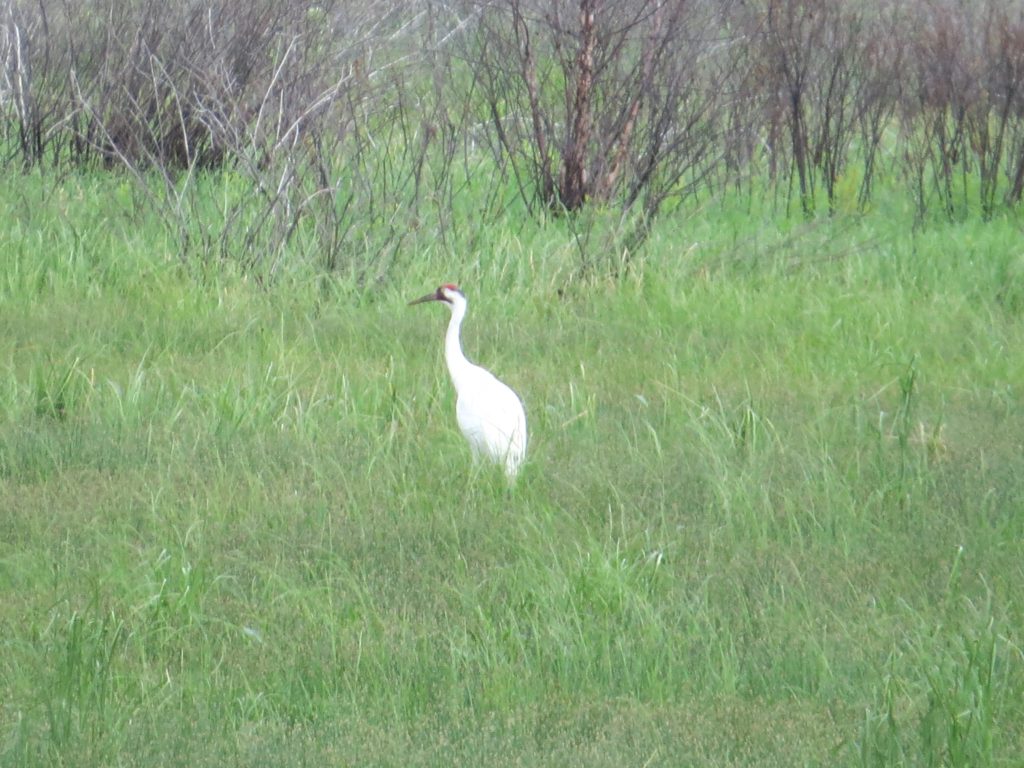 The three of us got out of the car to enjoy this easy lifer. Then I looked back toward the vehicle and spied a second bird in a waterway that had been hidden by some trees. This one was much closer to the road and gave us some great photo ops.
The three of us got out of the car to enjoy this easy lifer. Then I looked back toward the vehicle and spied a second bird in a waterway that had been hidden by some trees. This one was much closer to the road and gave us some great photo ops.
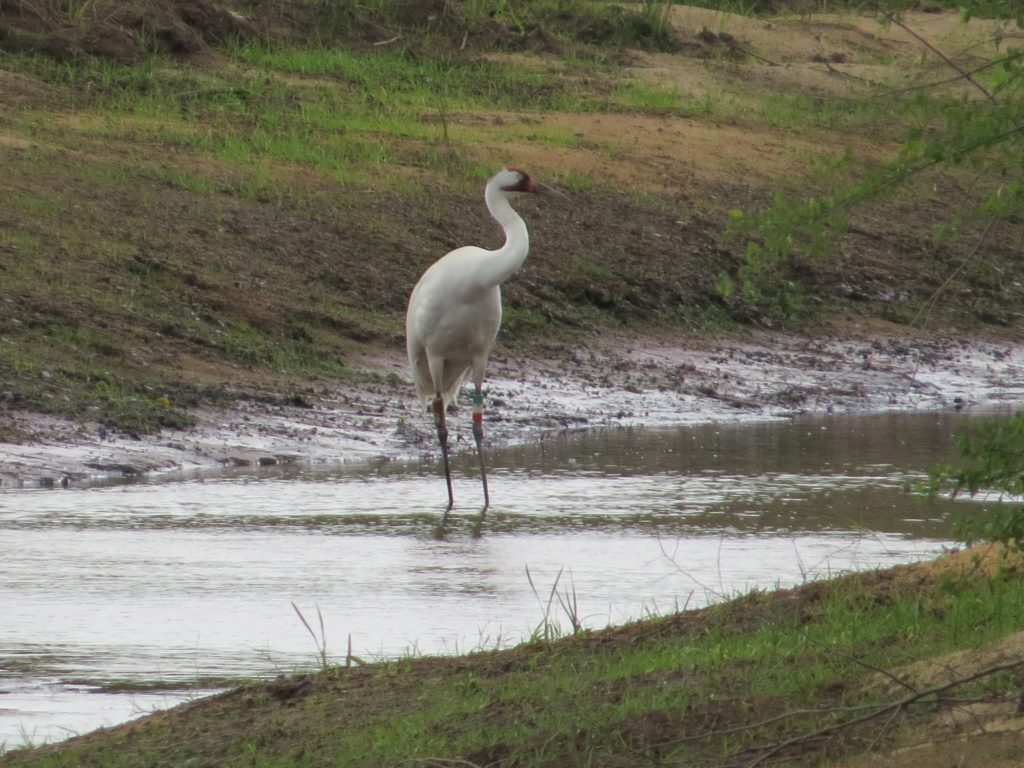
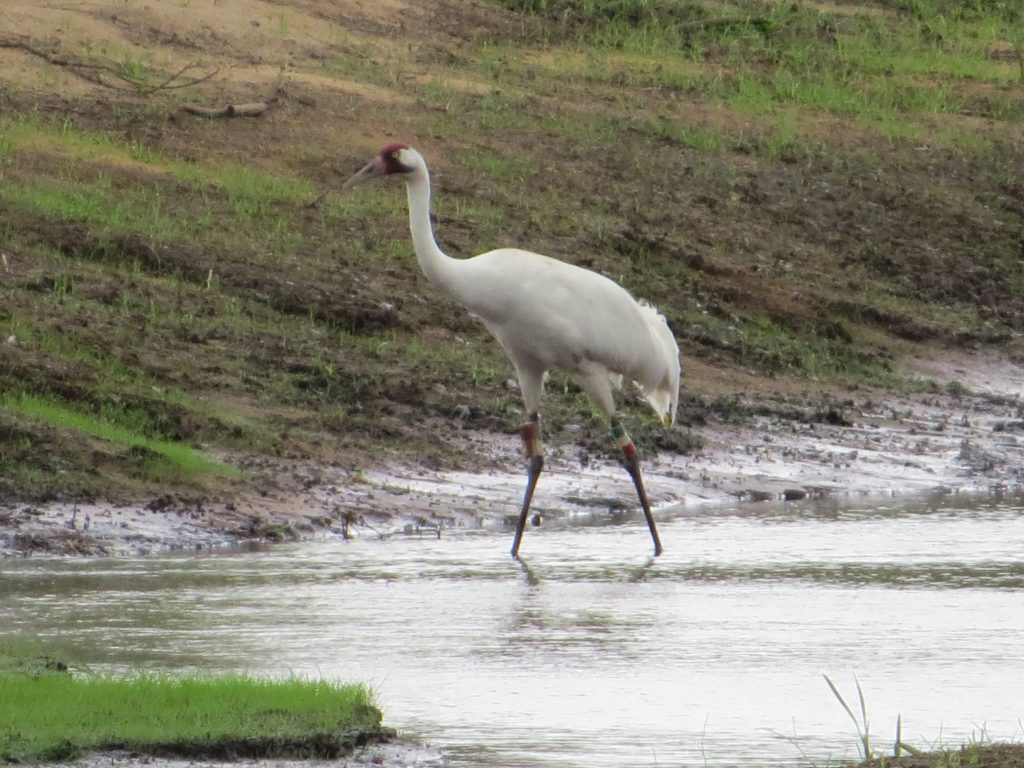
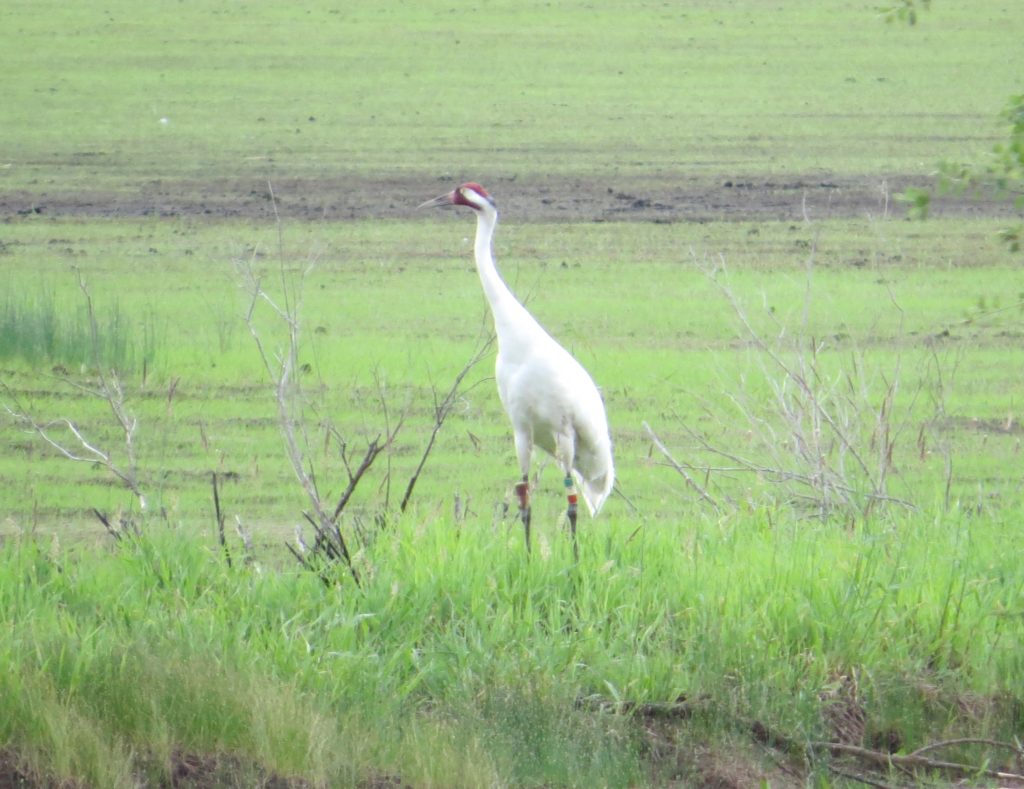 As we watched this Crane, something special happened. This one threw back its head and bugled for us! It was the loudest and coolest thing I’ve ever heard come out of a bird. It sounded kind of like a Trumpeter Swan, only much more impressive. Speaking of impressive, this bird stands at 52″ tall before it does this. That’s roughly the same height as Evan.
As we watched this Crane, something special happened. This one threw back its head and bugled for us! It was the loudest and coolest thing I’ve ever heard come out of a bird. It sounded kind of like a Trumpeter Swan, only much more impressive. Speaking of impressive, this bird stands at 52″ tall before it does this. That’s roughly the same height as Evan.
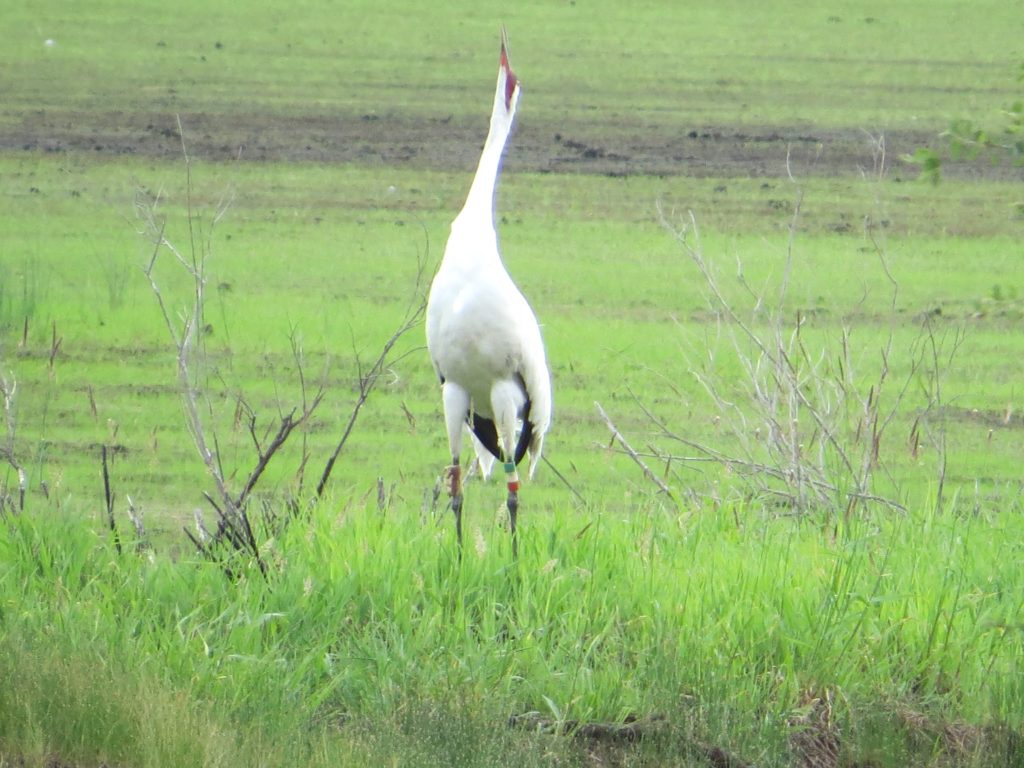
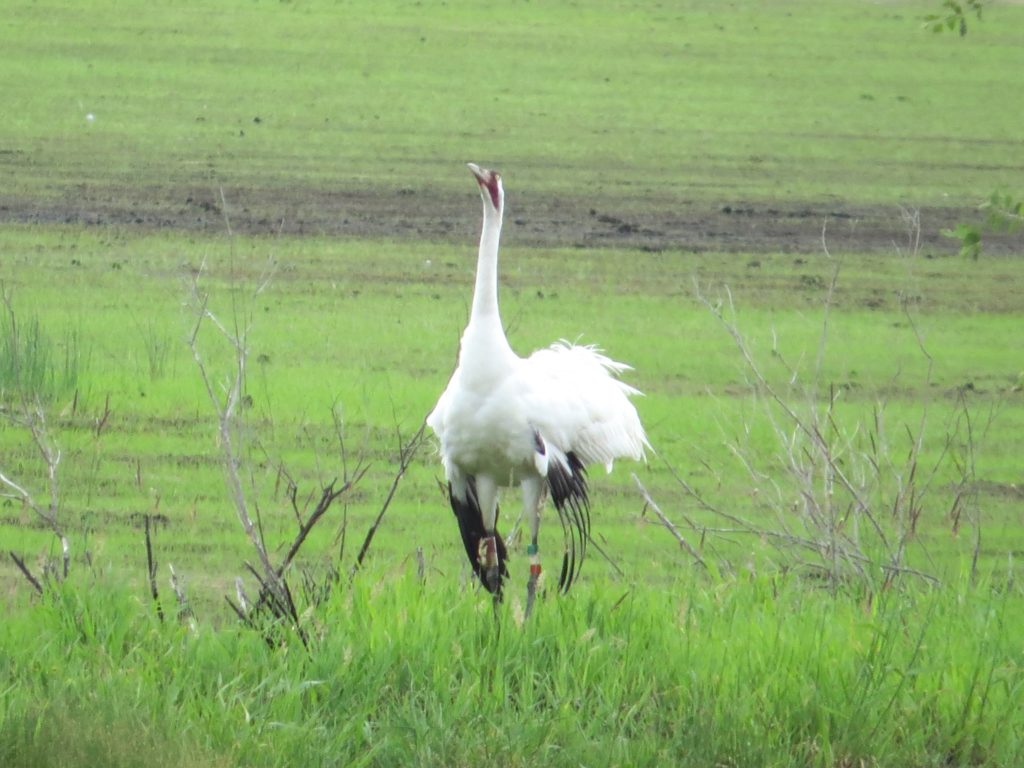 The three of us really enjoyed watching these birds.
The three of us really enjoyed watching these birds.
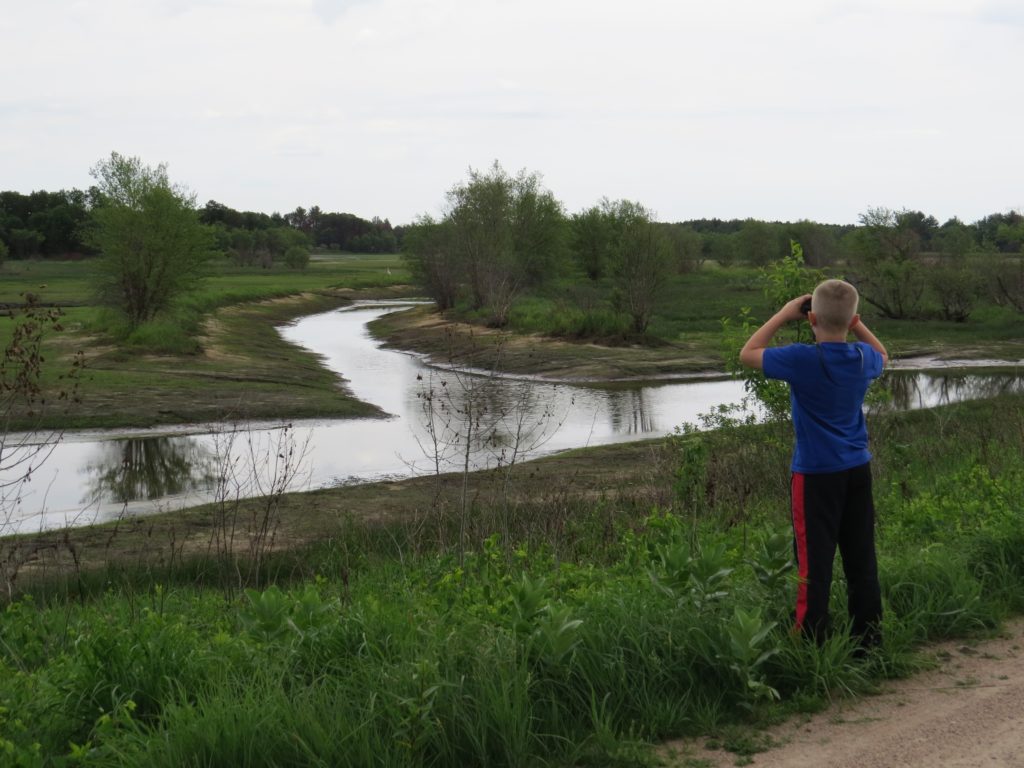 Here are Evan and Tommy each observing a different Crane. The one Tommy is looking at is visible in the photo. Evan is looking at the first one we found.
Here are Evan and Tommy each observing a different Crane. The one Tommy is looking at is visible in the photo. Evan is looking at the first one we found.
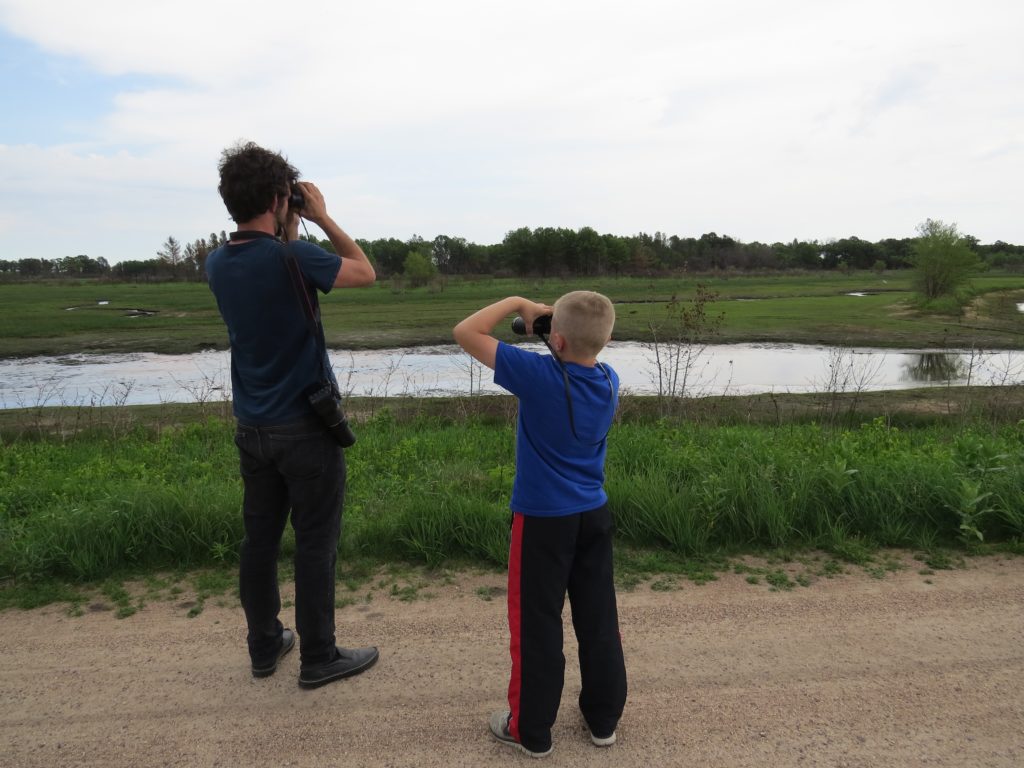
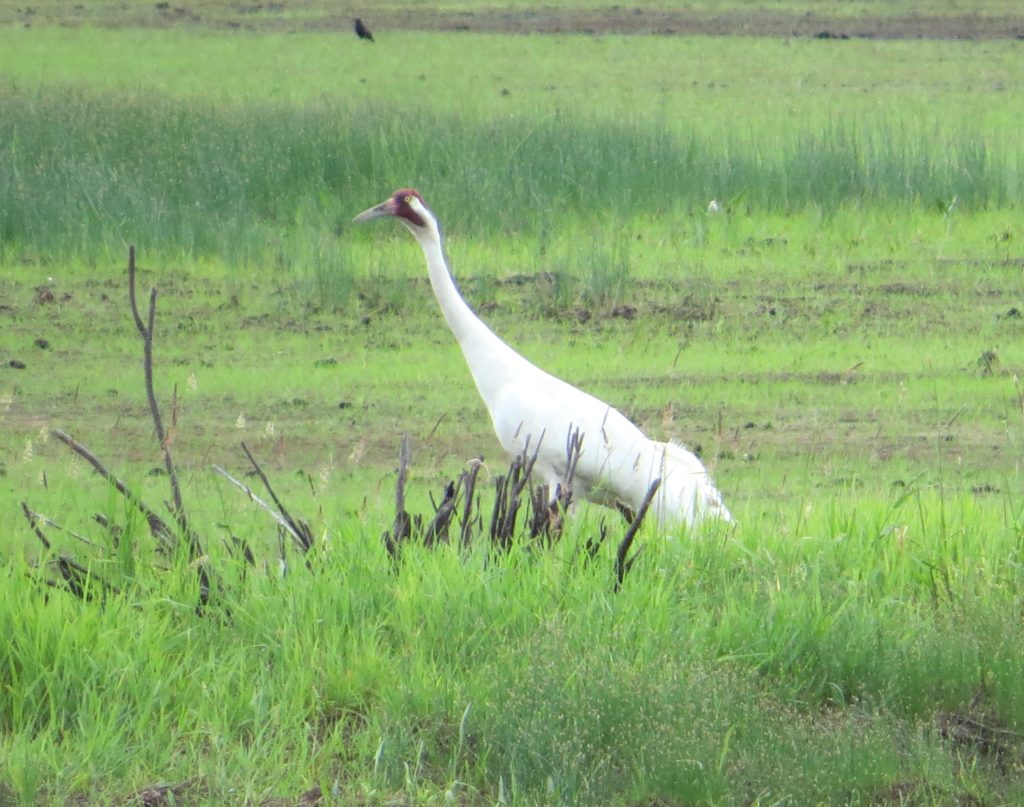 The Whooping Crane is one massive bird:
The Whooping Crane is one massive bird:
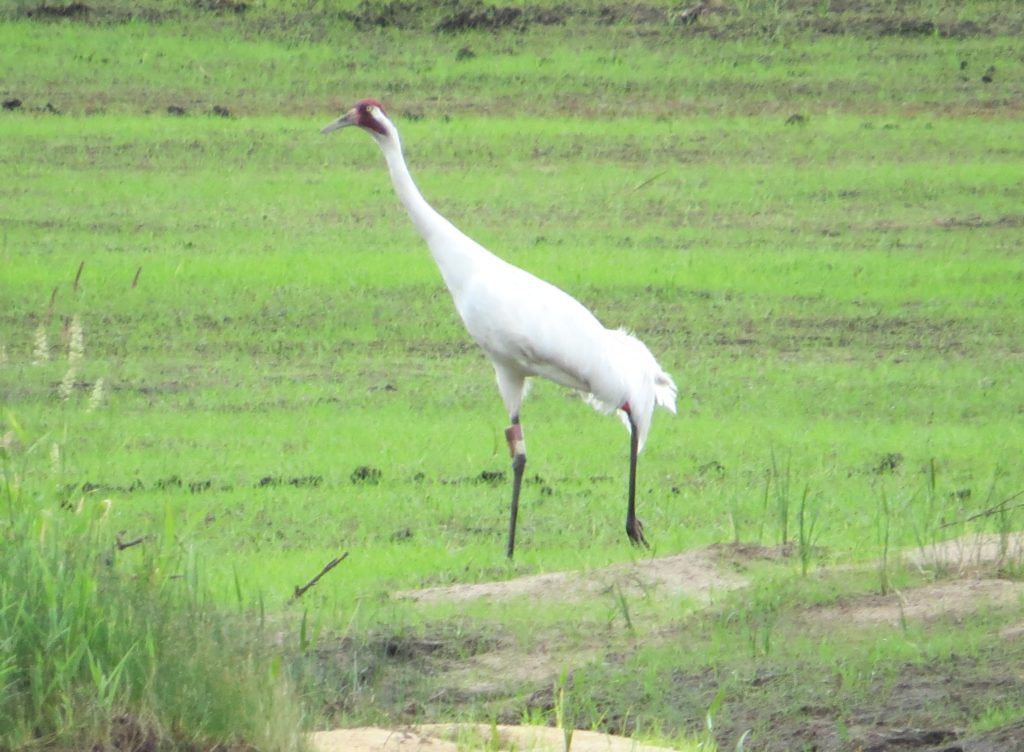 This cooperative bird eventually flew off and joined the much more distant Whooper. So the three of us decided to keep exploring Necedah. Necedah ended up being a phenomenal birding spot, so much so that I will save the rest for a different post and just focus on the Cranes from there in this post. I’ll just say that Necedah plays host to some other beautiful birds, who are also struggling in numbers.
This cooperative bird eventually flew off and joined the much more distant Whooper. So the three of us decided to keep exploring Necedah. Necedah ended up being a phenomenal birding spot, so much so that I will save the rest for a different post and just focus on the Cranes from there in this post. I’ll just say that Necedah plays host to some other beautiful birds, who are also struggling in numbers.
One of our stops at Necedah was the Visitors Center which is another great place to see Whoopers, even if it is from a distance. Here we saw two more. These birds were a long ways away. It just goes to show how big and how white these things are. Impressive doesn’t begin to describe it.
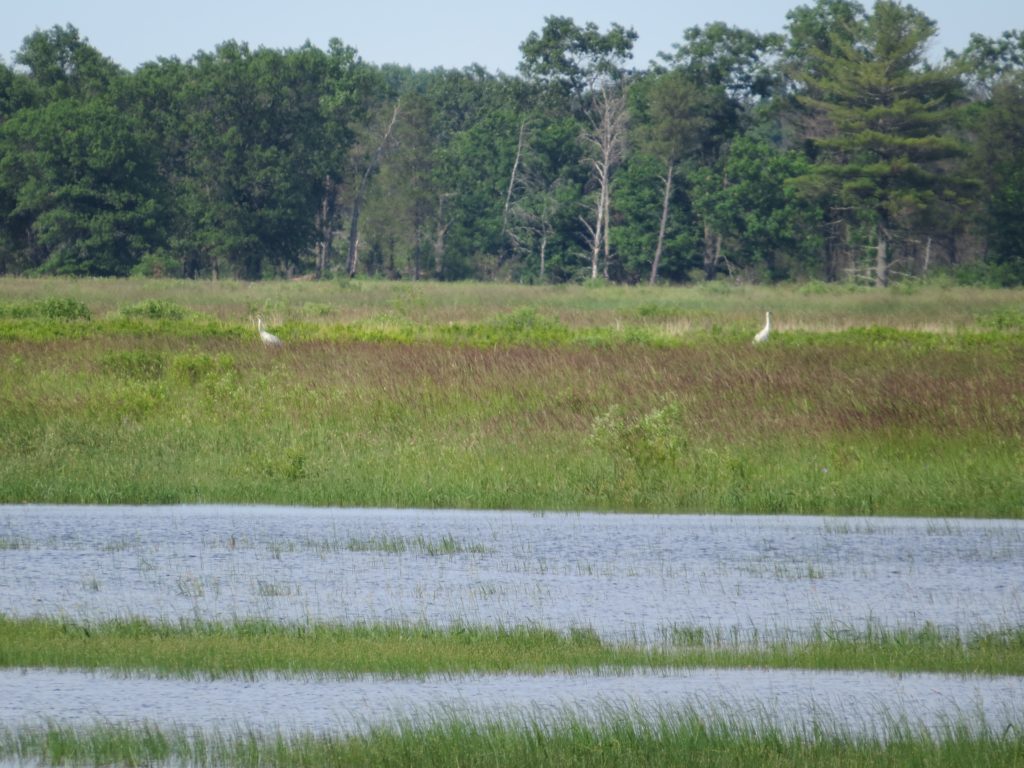 The Visitors Center also allowed us a humorous reprieve from the serious birding with some clowning around and a photo op.
The Visitors Center also allowed us a humorous reprieve from the serious birding with some clowning around and a photo op.
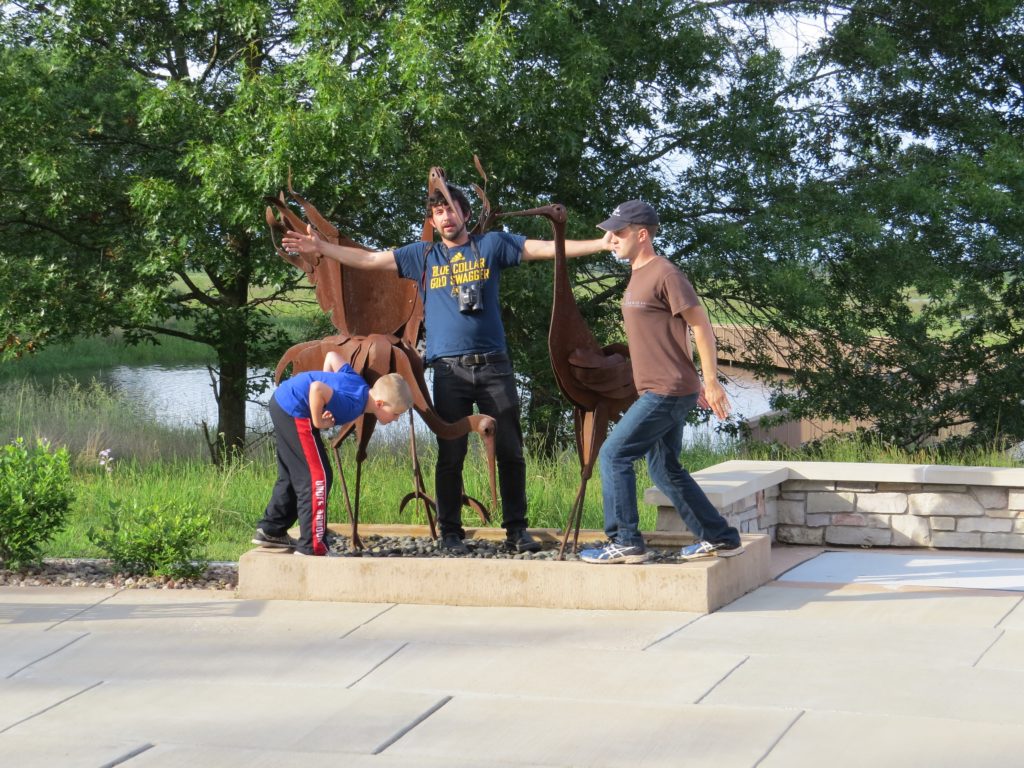 As I was monkeying with the settings for the self-timer on my camera, I ended up getting this gem on accident.
As I was monkeying with the settings for the self-timer on my camera, I ended up getting this gem on accident.
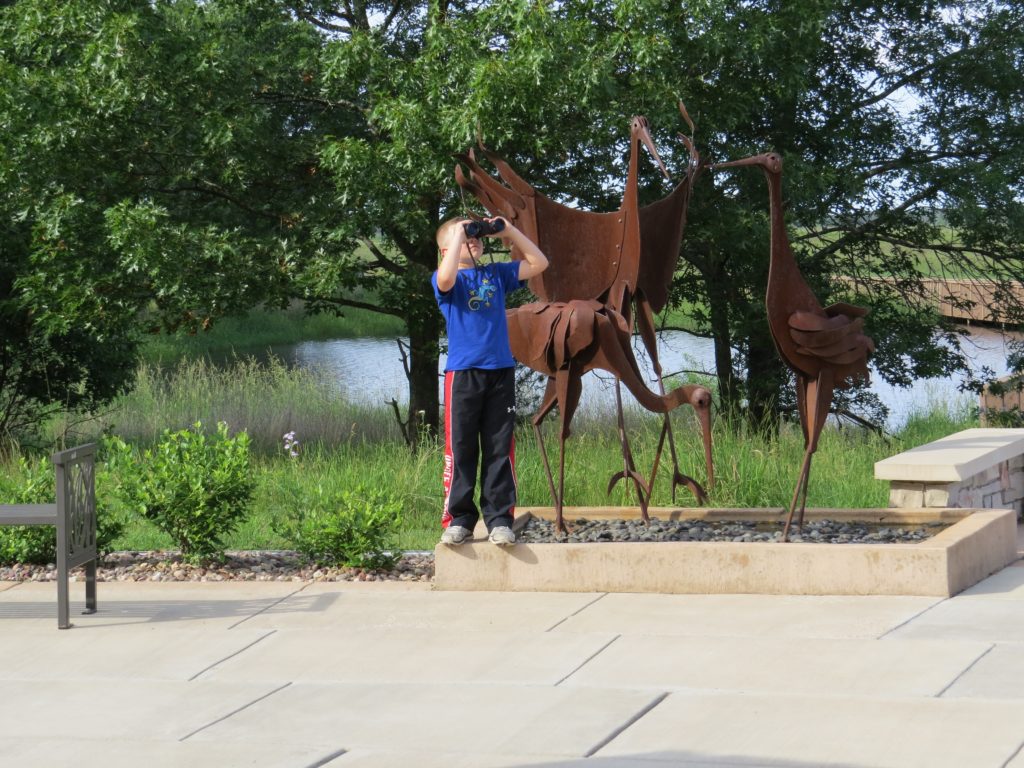
“Where are the Whoopers?”
Now we move on to Part Two of the endangered species search which occurred the very next morning, the hunt for the Kirtland’s Warbler. This post is bittersweet for me, sweet because we had smashing success with the Whooper, bitter because the Kirtland’s encounter was mediocre. I suppose, though, that “bittersweet” is how you would describe any endangered species sighting–a thrill to see such a bird only to be tempered with the knowledge of how few of them there are.
Anyway, thanks to my previously mentioned birding friend, we had a good idea of where to look for the now regularly established Adams County population of Kirtland’s Warblers. Joining us were Arizona birding friends Gordon Karre and Chris Rohrer who were also in Wisconsin for some birding. So just how good was the spot we were in? Well, when you are standing on a public road and get interrogated by two separate KIWA nest monitors AND a WDNR conservation officer, you know you are in the hot zone. Let me tell you that Wisconsin is all about protecting this bird, of which there are only a few dozen in the state. The bulk of Kirtland’s Warblers (maybe 4,000 birds) reside in the Grayling, Michigan area. That is where most birders eventually go to get their lifer. After license plate numbers were taken down and we were pre-warned (even without doing anything wrong) while standing on a public road, we dared not do anything immoral or illegal, lest some black helicopters would appear from the horizon to take us away to some secret government prison. Those Warblers are safer than any government secret; not even Ft. Knox is so well guarded. Humor aside, the nest monitors and conservation officer were friendly and courteous, but stern. We could tell that the nest monitors wanted to help us out further, but they were very honorable in their actions and did not compromise whatever solemn vow they took for the WDNR not to disclose any information. And full disclosure here: my birding friend is not one of the KIWA project volunteers; this site is well known to inner-circle birders of central Wisconsin. I will not be disclosing this person’s name or where we were searching in Adams County so as to not get this person in any kind of trouble. We were very grateful for that person’s help.
So did we see it? No, we did not despite trying for several hours. We did get to hear one very close to the road. However, its vocalizations were very infrequent, and it never did pop up to the top of one of the Pines to sing. Regardless, it was neat to be in the proximity of one and hear its loud, distinctive song. There is a Kirtland’s Warbler somewhere in the trees in this photo.
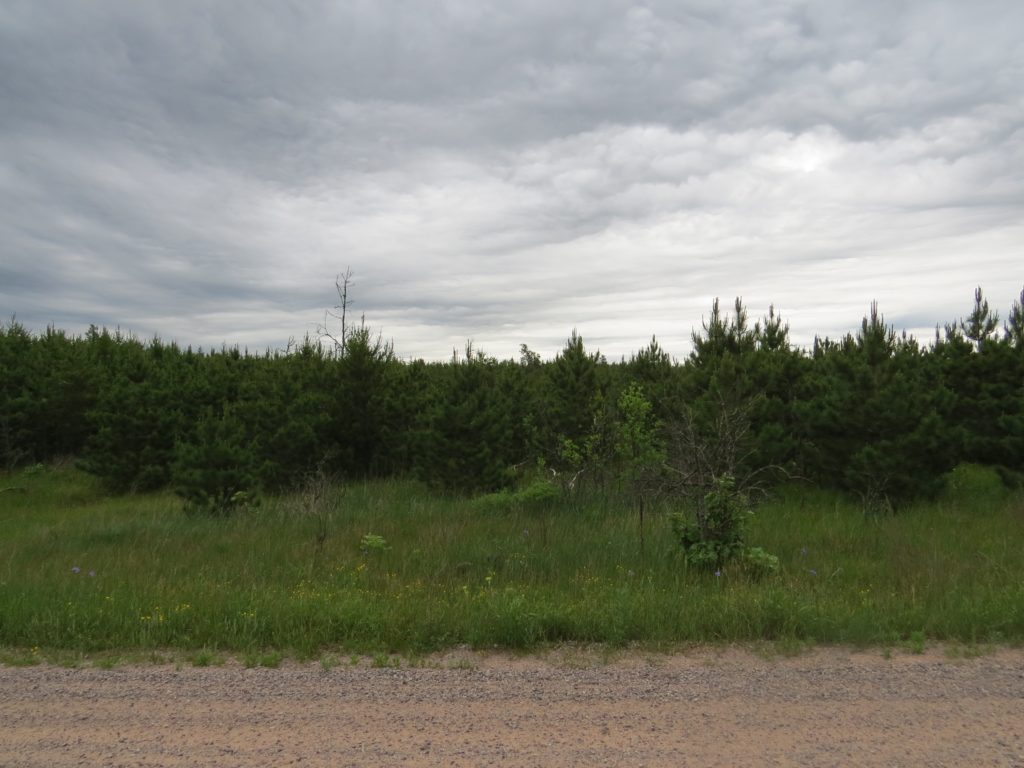
The Kirtland’s Warbler is an interesting species in that it has very specific habitat requirements, mostly large stands of Jack Pine that are about 10 feet tall and have some grassy space in between. Once the trees get taller than that, the Kirtland’s do not use that area anymore. Further complicating this is that Jack Pine cones only open in fire, so keeping appropriate habitat available for this bird is quite the complicated management process involving logging and/or controlled burns. What was cool about the Wisconsin Kirtland’s is that they have adapted to using stands of Red Pines with a mix of some Jack Pine. Because Red Pines are used in the lumber industry, Red Pine forests occur in many areas and are regenerated through normal human activity thus creating stands of trees that are the right height for this bird. What’s neat is that these Warblers are on private land that is owned by a lumber company that is working cooperatively with state and federal government agencies to ensure these Warblers have suitable habitat for several decades to come. Cool, huh?
So we ended up being 1.5 for 2 on our search for two endangered species that call Wisconsin home. It was good to see Gordon again (we’ve now birded together in three states!) and to finally get my Chris Rohrer lifer (a vagrant sighting even!). Those guys tried again for the Kirtland’s the next morning and had tremendous success, getting killer looks and photos. Even though Tommy, Evan, and I didn’t win the entire lottery, it was no doubt a fun, successful trip. Like all good trips, though, it left us wanting more. Wisconsin, we will be back!
Whooping Crane
Carver Park Reserve–Reserved for the Warbler Elite
The day after our Falls Creek SNA adventure, visiting Arizona friend Tommy DeBardeleben went on an overnight solo trip to Grand Forks, North Dakota where he successfully got his target bird, the Short-eared Owl with Sandy Aubol’s help. Tommy is doing an Owl Big Year where he must see and photograph all 19 Owl species that can be found in the U.S. Short-eared Owl was Tommy’s 18th Owl species on the year, leaving him with just the Boreal Owl not yet seen with the better part of the year remaining. Even at one shy, Tommy’s quiet pursuit is quite remarkable and unique even in a year when everyone’s attention is on the historic Big Year race going on right now in which Olaf Danielson and John Weigel will both likely smash Neil Hayward’s record of 749. Number chasing is nothing new and has lost some of its luster. On the other hand, Tommy’s pursuit of quality sightings and focus on completion of a singular group of birds–difficult birds–is a refreshing take on an otherwise banal goal. You can follow Tommy’s Owl Big Year (TOBY) and his Minnesota trip reports on his blog.
Once Tommy got back, there was no rest for him as we geared up for another high octane adventure to Wisconsin. Two endangered species were on the menu (figuratively speaking of course), but those will have to wait for another post because on our way east we made a stop in the Twin Cities to try to add a very rare Warbler to Tommy’s life list.
Our destination was Carver Park Reserve, a sprawling park complex of prairie, woodland, and lake habitats enjoyed by hikers, bikers, campers, and birders alike. Our target was not the Blue-winged Warbler, though that is a very good bird for the state and one that can be enjoyed in good numbers and with ease from paved biking trails at Carver Park Reserve.
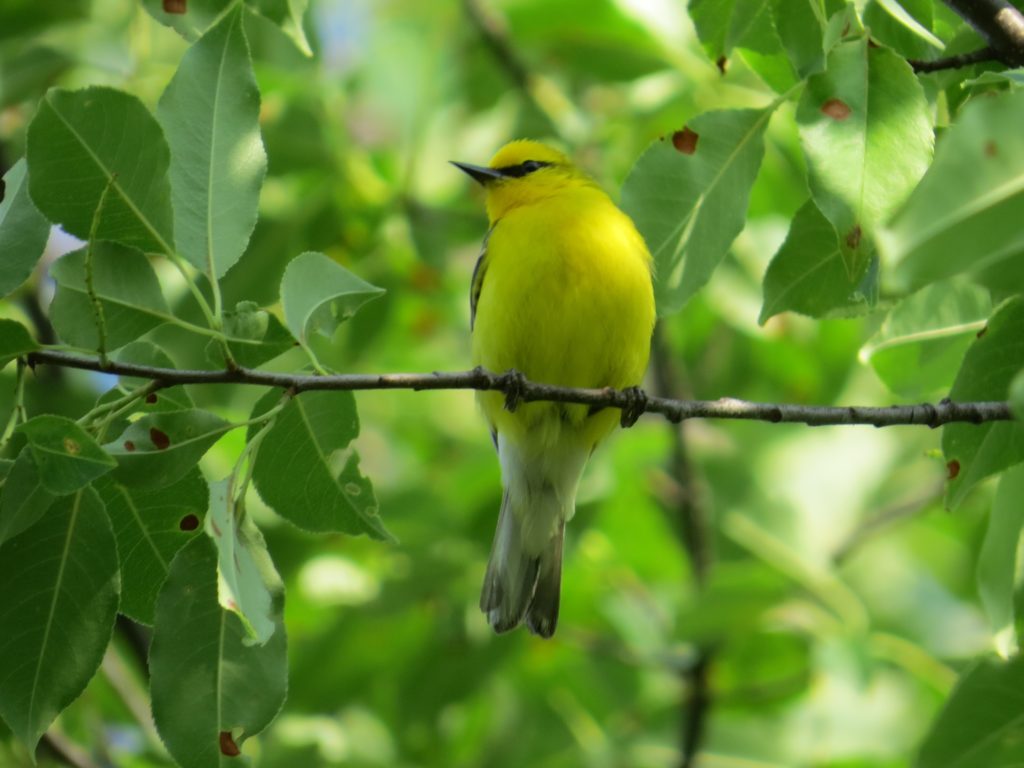
We were serenaded by the bee-buzzzzz of three different males. Nice birds, but still not what we were after.
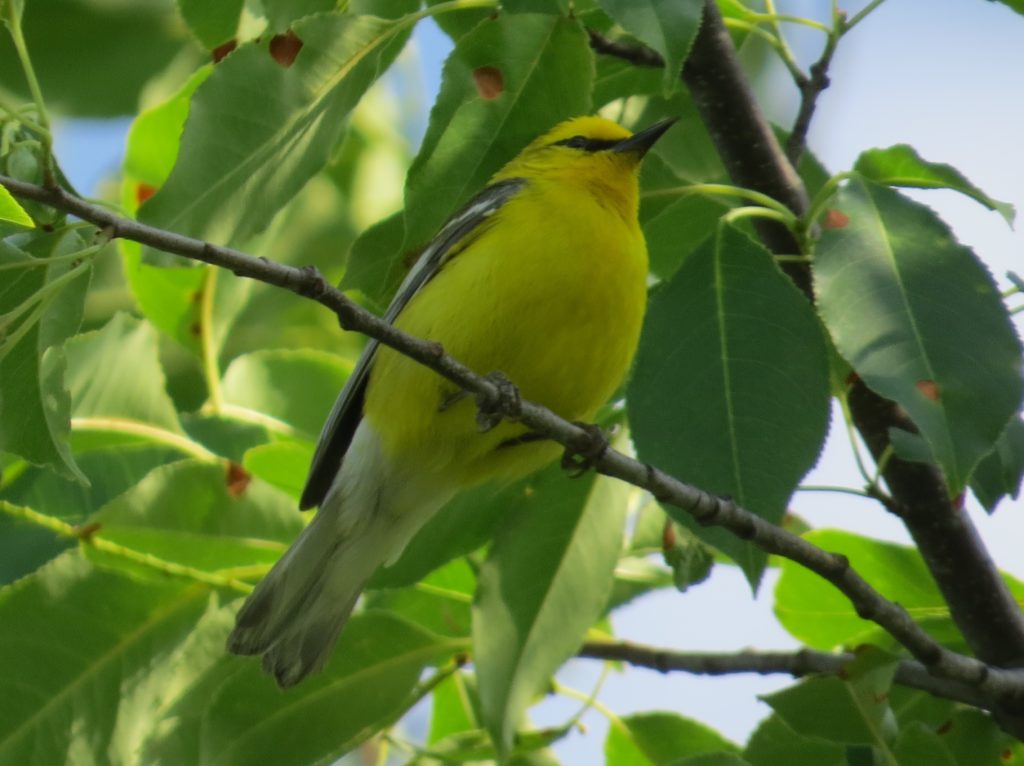 We were after one of the most coveted and beautiful Warblers there is–the Cerulean Warbler. This is one of my all-time favorite birds. This individual was only the fourth one I’ve ever seen; it’s one of those birds that makes you feel like you are lifering all over again when you see it, it’s that cool. This bird is so rare, beautiful, and cooperative–no apologies on this photo dump.
We were after one of the most coveted and beautiful Warblers there is–the Cerulean Warbler. This is one of my all-time favorite birds. This individual was only the fourth one I’ve ever seen; it’s one of those birds that makes you feel like you are lifering all over again when you see it, it’s that cool. This bird is so rare, beautiful, and cooperative–no apologies on this photo dump.
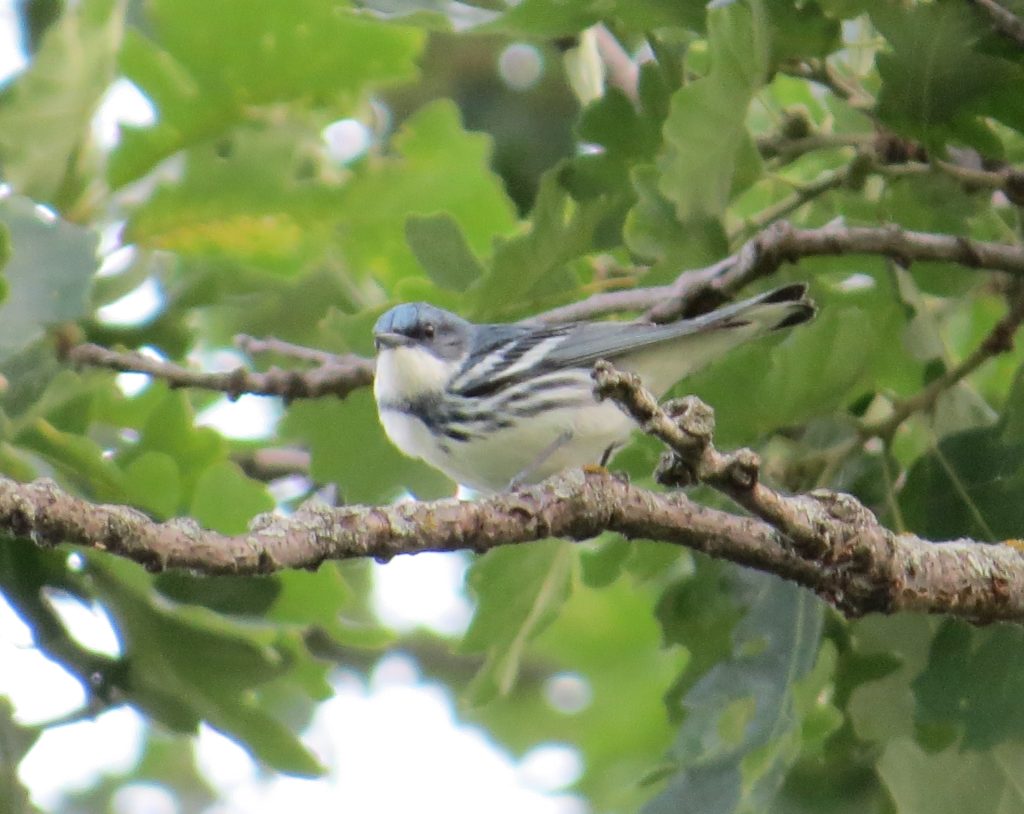
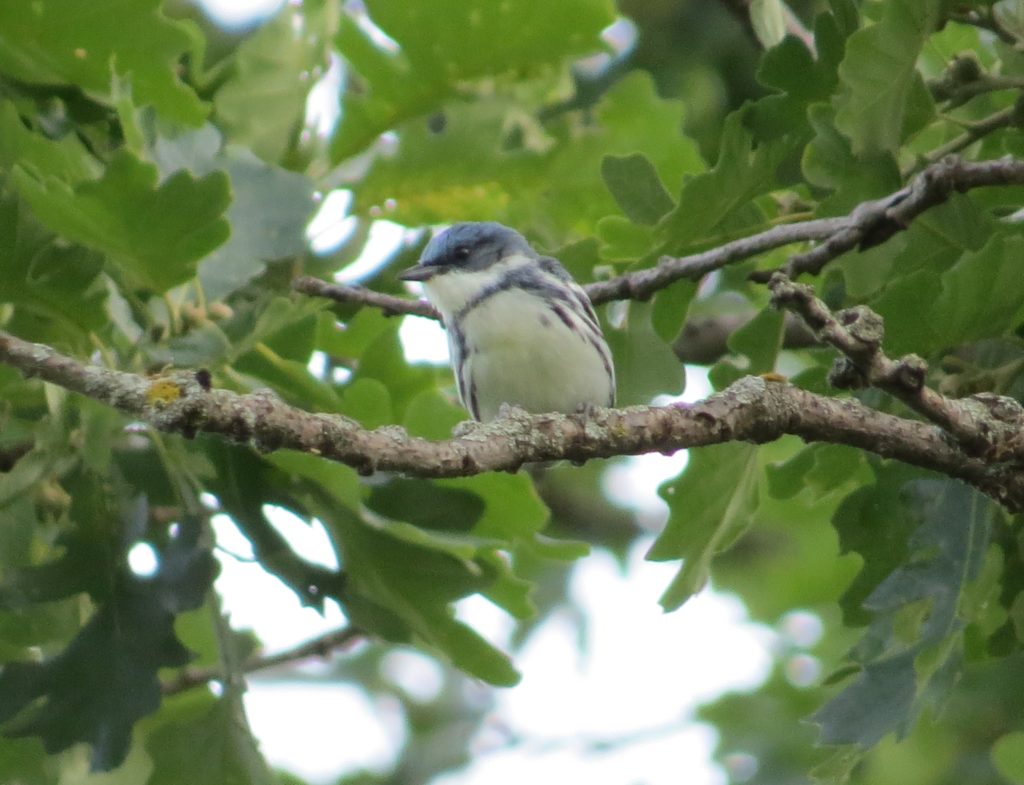
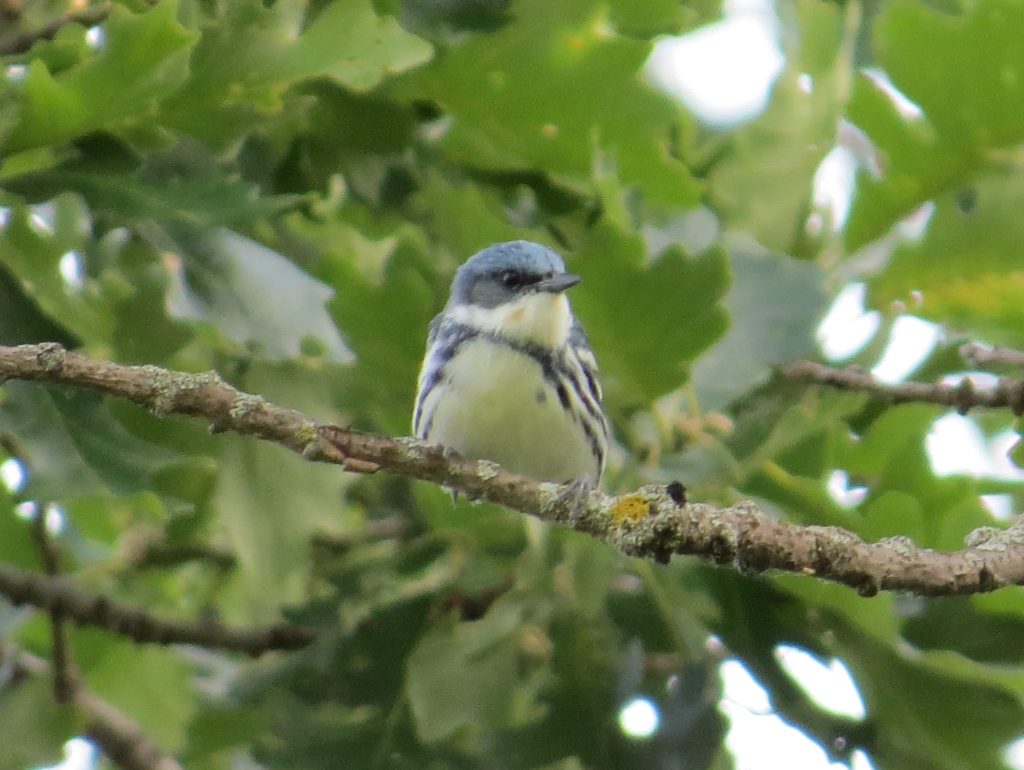
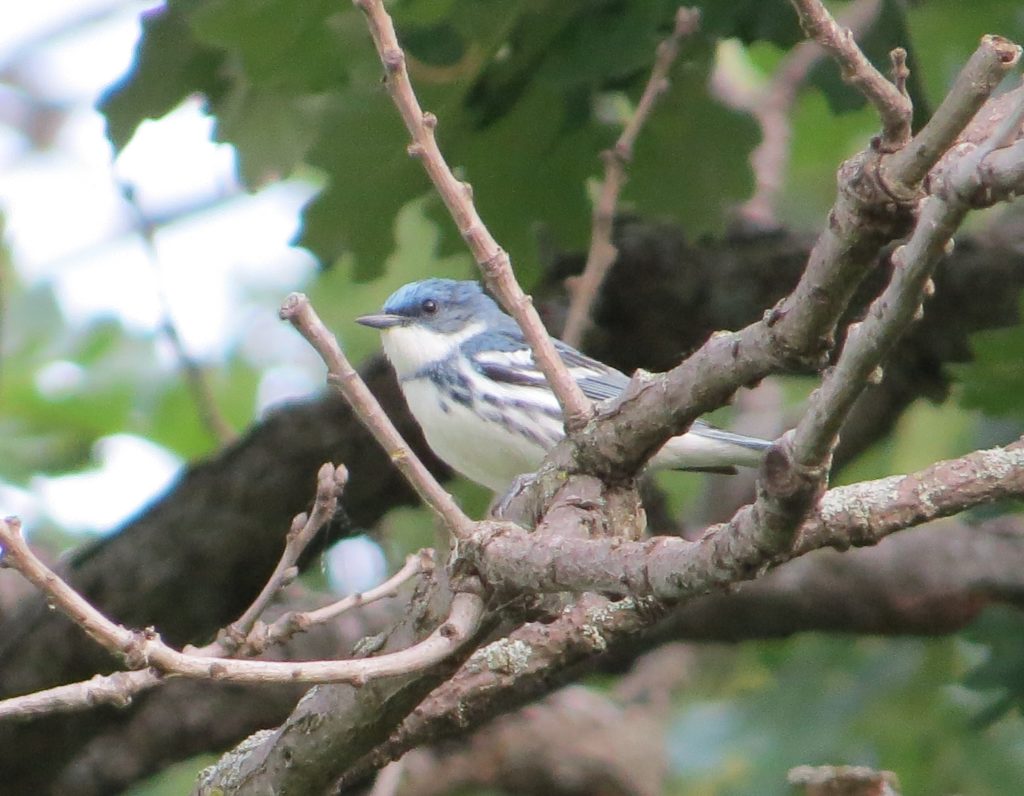
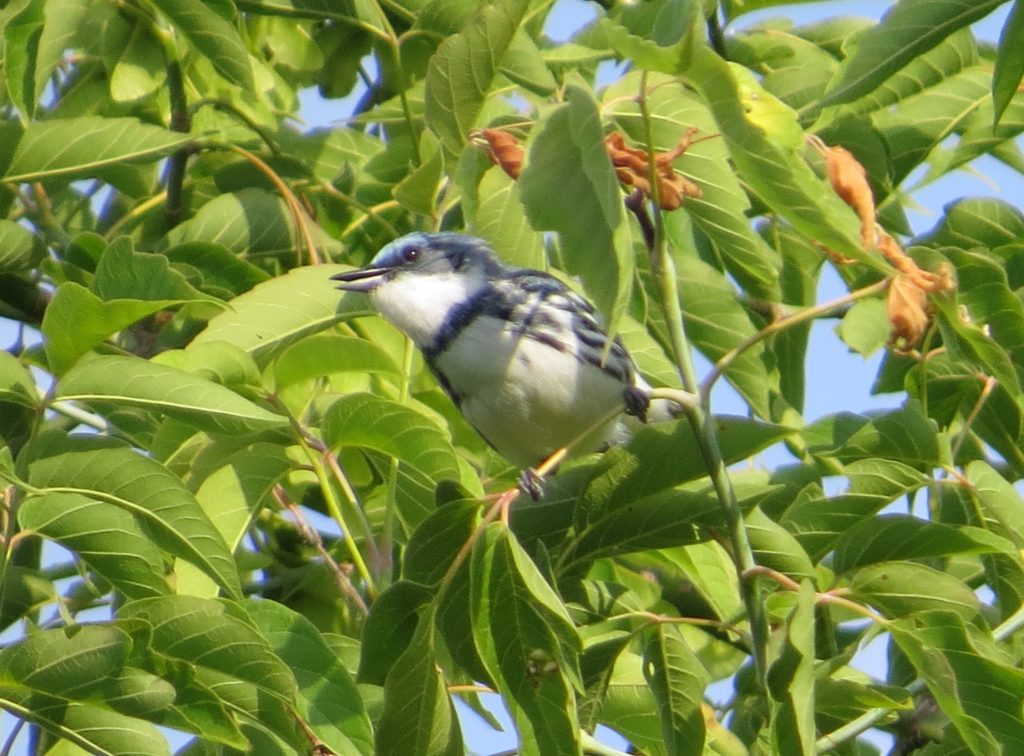 The Cerulean Warbler is in trouble because of habitat loss in its summer home in North America and its winter home in South America. It prefers mature deciduous woods that offer a relatively open understory. Much of their historical breeding grounds in the U.S. have been lost to farms, cities, and suburbs. On their wintering grounds, much of the tropical forest has been converted to farms. While Ceruleans will use shade-grown coffee plantations, they will not use the more popular and efficient sun-grown coffee plantations. Seeing one of these birds is always a reminder of how fragile a species can be and how easily we can wipe a species off the map. It’s also a personal reminder that I really should be drinking bird-friendly, shade-grown coffee–it’s the least I can do. Seeing or even hearing a Cerulean is always a special treat. Seeing one well like this and watching a friend lifer on it is even better. And observing a Cerulean Warbler perched against a cerulean sky? Priceless.
The Cerulean Warbler is in trouble because of habitat loss in its summer home in North America and its winter home in South America. It prefers mature deciduous woods that offer a relatively open understory. Much of their historical breeding grounds in the U.S. have been lost to farms, cities, and suburbs. On their wintering grounds, much of the tropical forest has been converted to farms. While Ceruleans will use shade-grown coffee plantations, they will not use the more popular and efficient sun-grown coffee plantations. Seeing one of these birds is always a reminder of how fragile a species can be and how easily we can wipe a species off the map. It’s also a personal reminder that I really should be drinking bird-friendly, shade-grown coffee–it’s the least I can do. Seeing or even hearing a Cerulean is always a special treat. Seeing one well like this and watching a friend lifer on it is even better. And observing a Cerulean Warbler perched against a cerulean sky? Priceless.
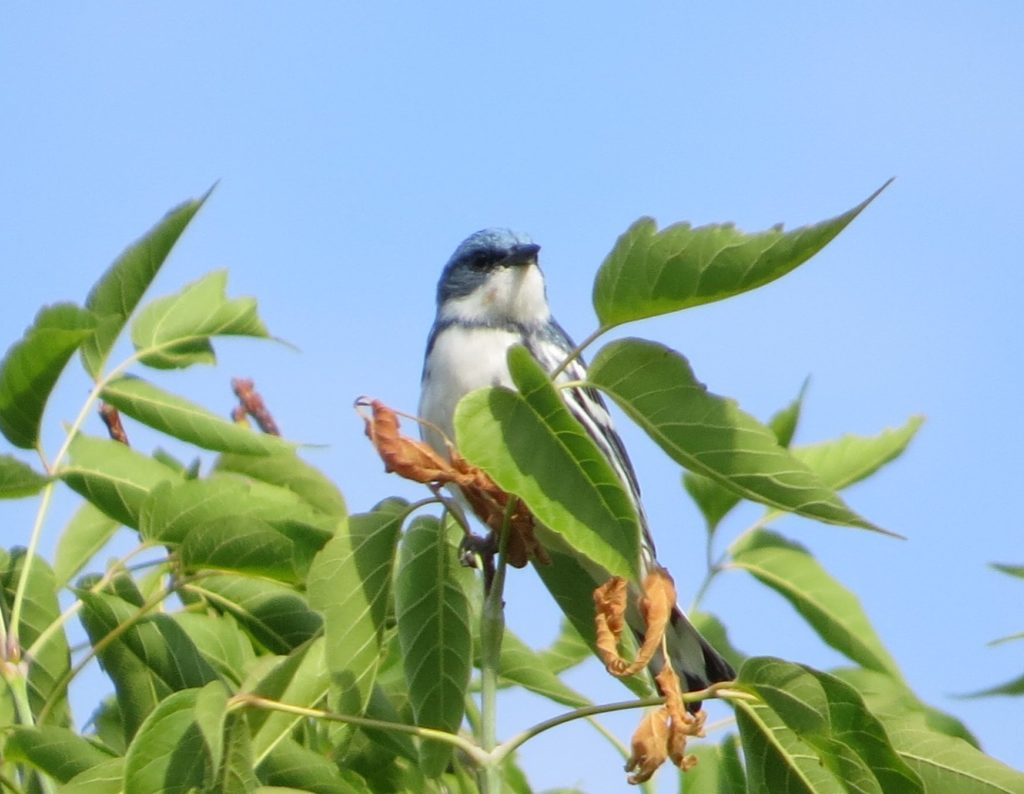
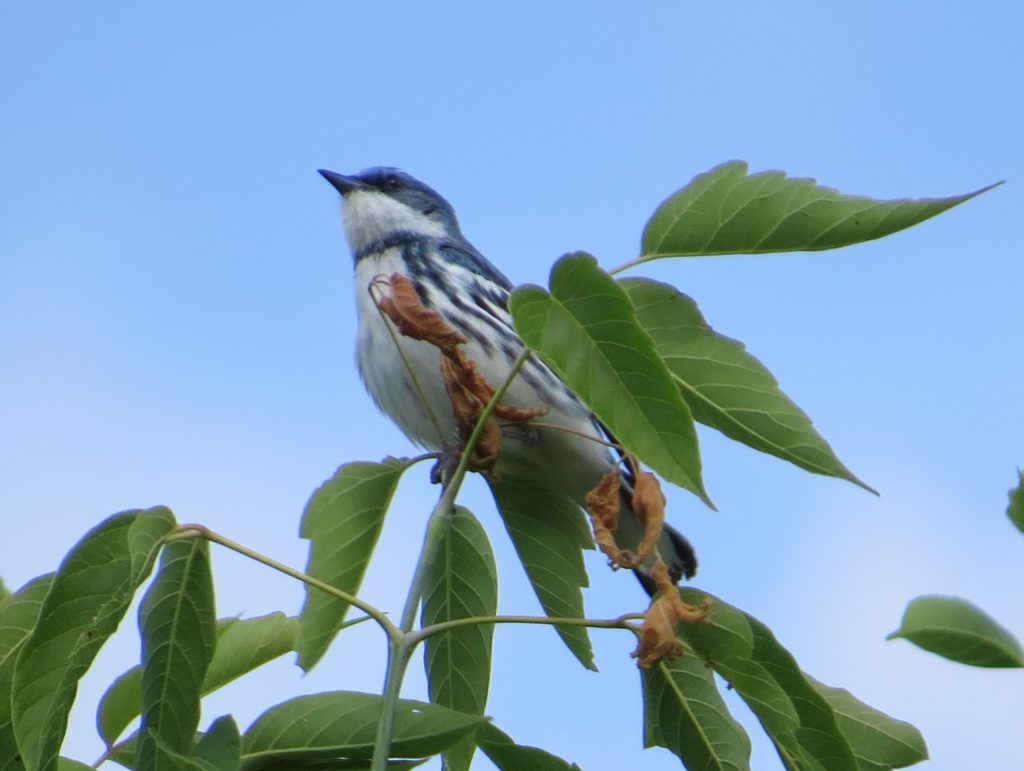 Coming up: a hefty, quick trip to Wisconsin for some unrivaled birds, CEWA notwithstanding.
Coming up: a hefty, quick trip to Wisconsin for some unrivaled birds, CEWA notwithstanding.
Mopping Up at Falls Creek SNA
There comes a point in one’s birding where the lifers in one’s own state slow down to a trickle and then just the occasional drip. I’ve seen it play out on blogs and with friends. It is inevitable. Luckily for me, Washington County’s Falls Creek Scientific and Natural Area still held the juicy potential for perhaps my last multi-lifer day in Minnesota. Two southeastern specialties that have an extremely limited range along just the eastern border of the state have been known to breed here, the Acadian Flycatcher and the Louisiana Waterthrush. In fact, this is about as far north as these two breed. Like a scene out of the Pacific Northwest, Falls Creek offers steep ravines with towering Pines and mature deciduous forests with an open understory. It is the perfect habitat for the Acadian Flycatcher, and the Louisiana Waterthrush thrives along the small, yet swift stream at the bottom of a ravine. There is nothing flashy about these two birds which is probably why this errand has been reserved for that point in my birding when there is little else to go after.
I saved the Falls Creek trip for when Arizona friend Tommy DeBardeleben came for his third Minnesota trip of 2016. He also needed the Acadian along with several of our eastern woodland species, many of which are also present at Falls Creek. We could both do well here. It was a logical stop on our first full day of birding for Tommy’s week-long vacation.
Near the parking area was an open prairie area. One of the inhabitants of the brushy edge was a lifer for Tommy, the Blue-winged Warbler. This Warbler species also has a limited range in southeastern Minnesota, though we seem to be turning them up in lots of areas further north and west of where they are supposed to be according to range maps in field guides.
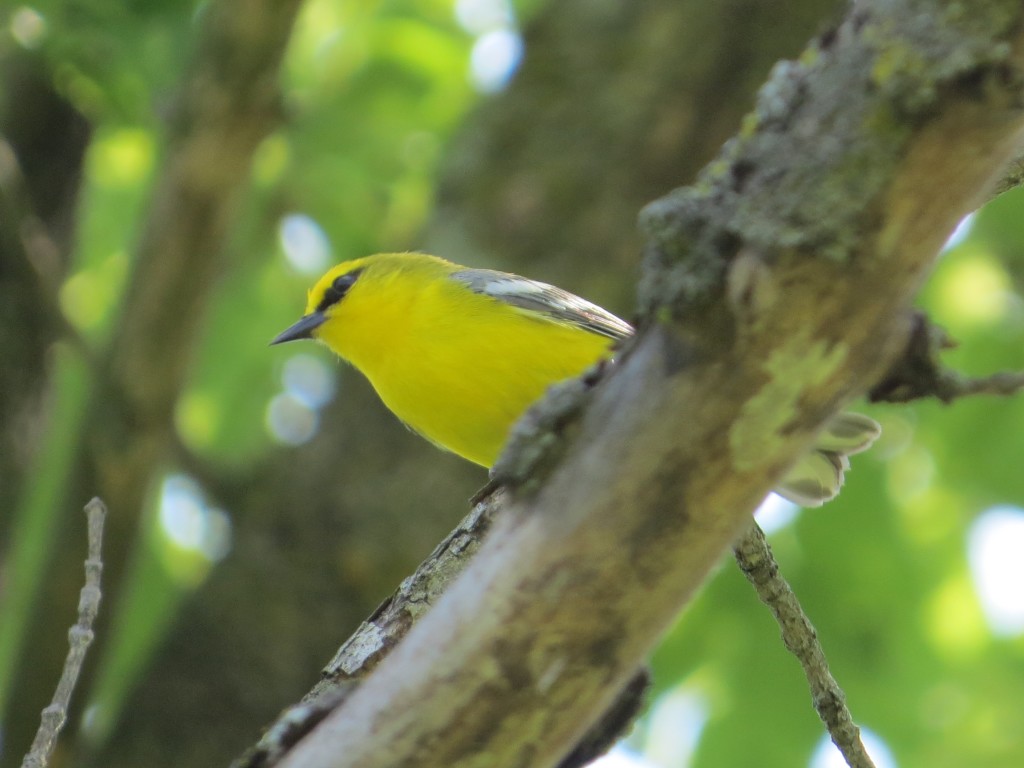 Once we hiked through the prairie habitat and into the woods, we walked along a trail on glacial ridge where the slopes quickly became quite steep on each side of the trail. Thanks to some great insights from Washington County birding guru, Pete Nichols, we cut down one of these slopes on a goat path of sorts to reach the creek in the ravine below. This was the promised land for BOTH the Louisiana Waterthrush and the Acadian Flycatcher. It did not take long for us to hear the sharp “Pit-se!” call of our shared Acadian lifer. Arriving at the creek bottom, Tommy instantly pointed out the chip note of the Louisiana Waterthrush, which had the honor of being my 400th life bird. The bird showed well for us but would not sit still. Its song was beautiful as it rang through the ravine.
Once we hiked through the prairie habitat and into the woods, we walked along a trail on glacial ridge where the slopes quickly became quite steep on each side of the trail. Thanks to some great insights from Washington County birding guru, Pete Nichols, we cut down one of these slopes on a goat path of sorts to reach the creek in the ravine below. This was the promised land for BOTH the Louisiana Waterthrush and the Acadian Flycatcher. It did not take long for us to hear the sharp “Pit-se!” call of our shared Acadian lifer. Arriving at the creek bottom, Tommy instantly pointed out the chip note of the Louisiana Waterthrush, which had the honor of being my 400th life bird. The bird showed well for us but would not sit still. Its song was beautiful as it rang through the ravine.
Tommy and I had some shared objectives on this trip and some separate. We eventually split up to do what we needed to do–Tommy spent a good amount of time trying to get visuals on his Wood Thrush lifer (good luck!) while I really wanted visuals and photos of my two new life birds. Not only were the birds difficult to find and difficult to pin down, but the low light conditions made photography a challenge.
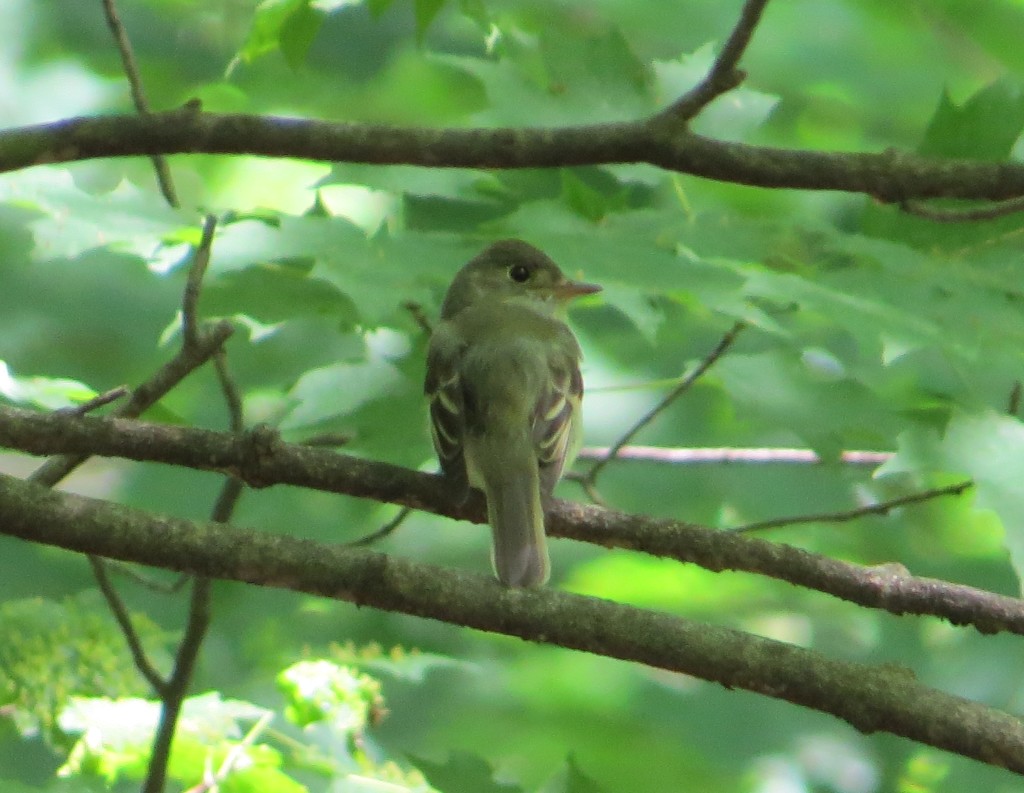 Confession: I’m starting to really like the Empids, at least the eastern ones. Though the five are difficult to differentiate visually, their unique habitat choices and equally unique songs make identification a lot easier than I once thought. Hearing this Acadian Flycatcher was much more fun than just seeing it.
Confession: I’m starting to really like the Empids, at least the eastern ones. Though the five are difficult to differentiate visually, their unique habitat choices and equally unique songs make identification a lot easier than I once thought. Hearing this Acadian Flycatcher was much more fun than just seeing it.
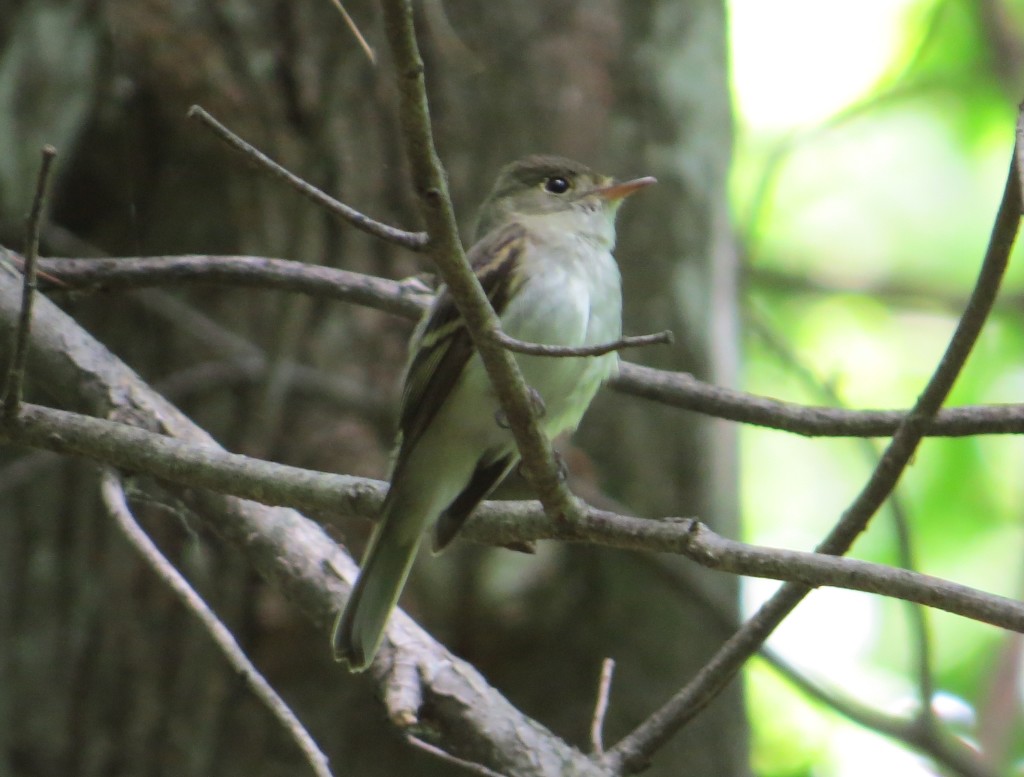 An equal auditory delight was the Louisiana Waterthrush. It was loud. We had at least two different birds. This one below put on an impressive spinning and tail-bobbing display on this log right in front of us.
An equal auditory delight was the Louisiana Waterthrush. It was loud. We had at least two different birds. This one below put on an impressive spinning and tail-bobbing display on this log right in front of us.
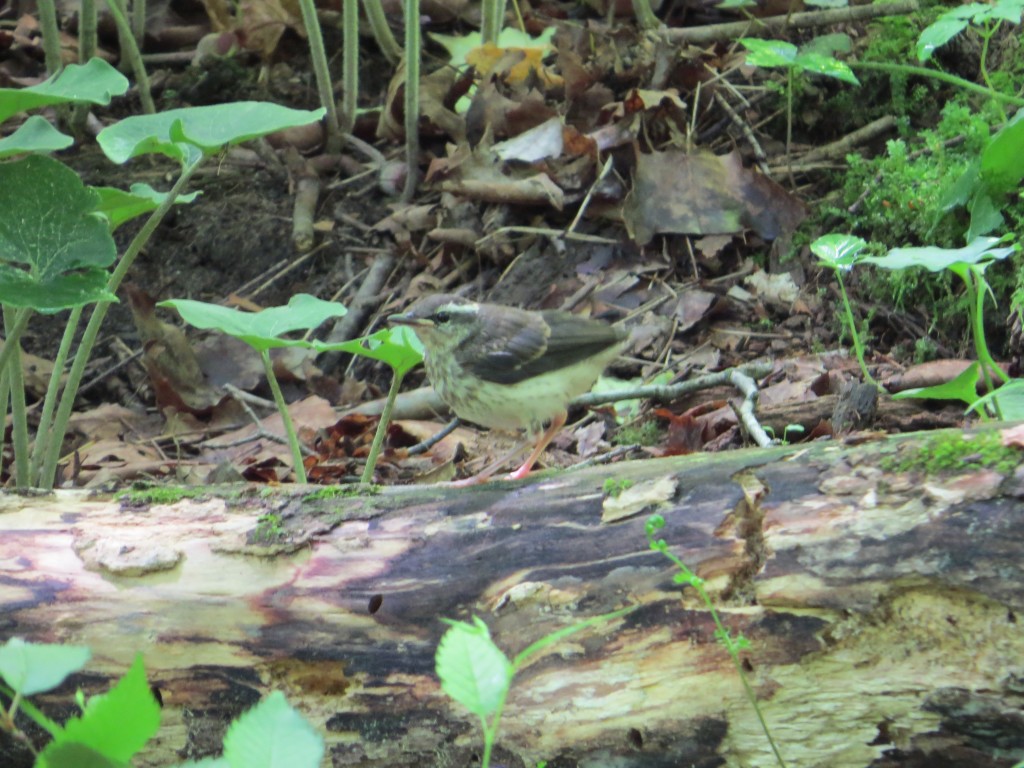
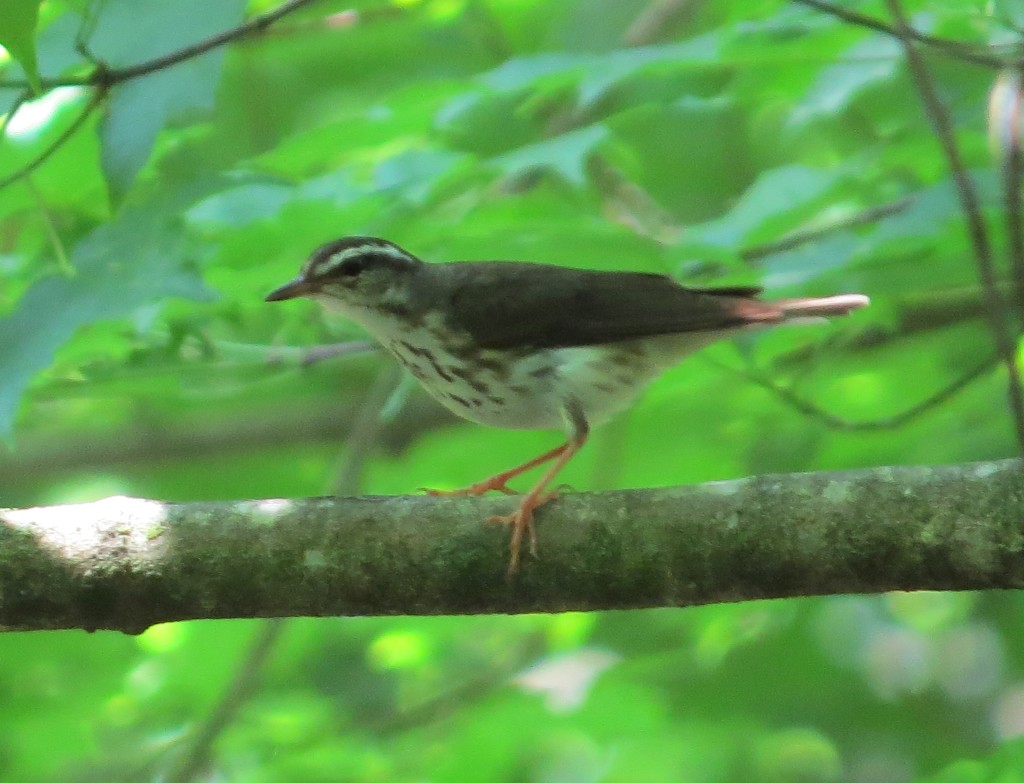 Tommy and I became absorbed in our separate pursuits spending more time than we anticipated in our searches. Is that a Scarlet Tanager? Nope, just a super content Evan who kept busy the entire time playing in the creek. Good thing he wore his water boots.
Tommy and I became absorbed in our separate pursuits spending more time than we anticipated in our searches. Is that a Scarlet Tanager? Nope, just a super content Evan who kept busy the entire time playing in the creek. Good thing he wore his water boots.
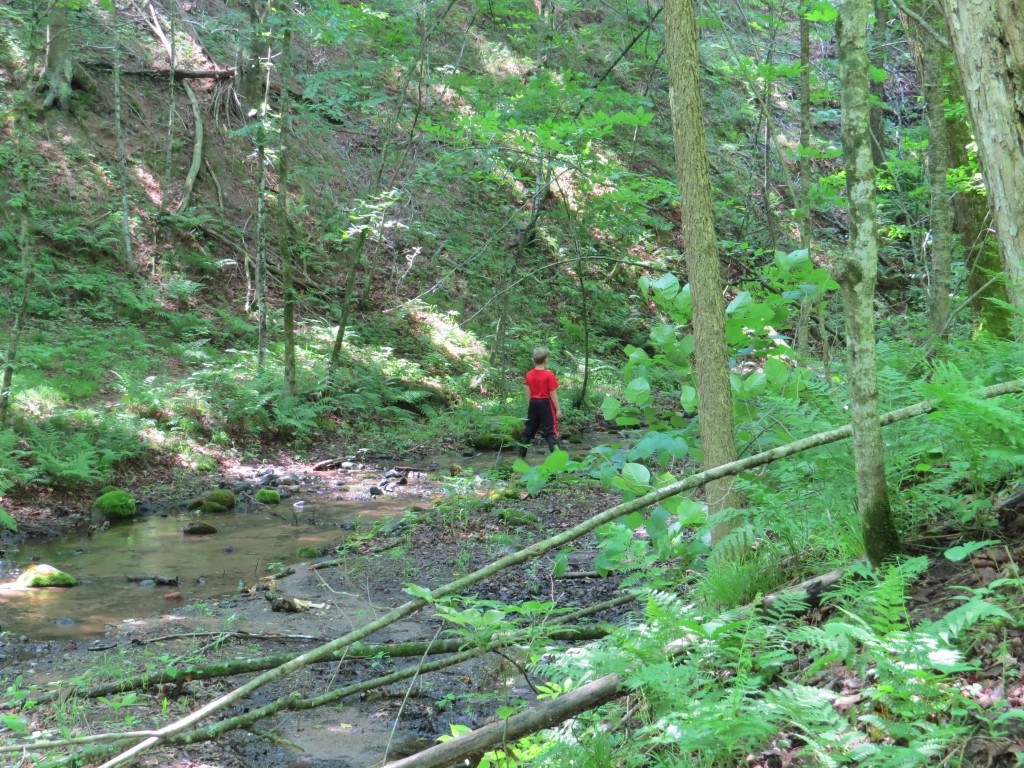
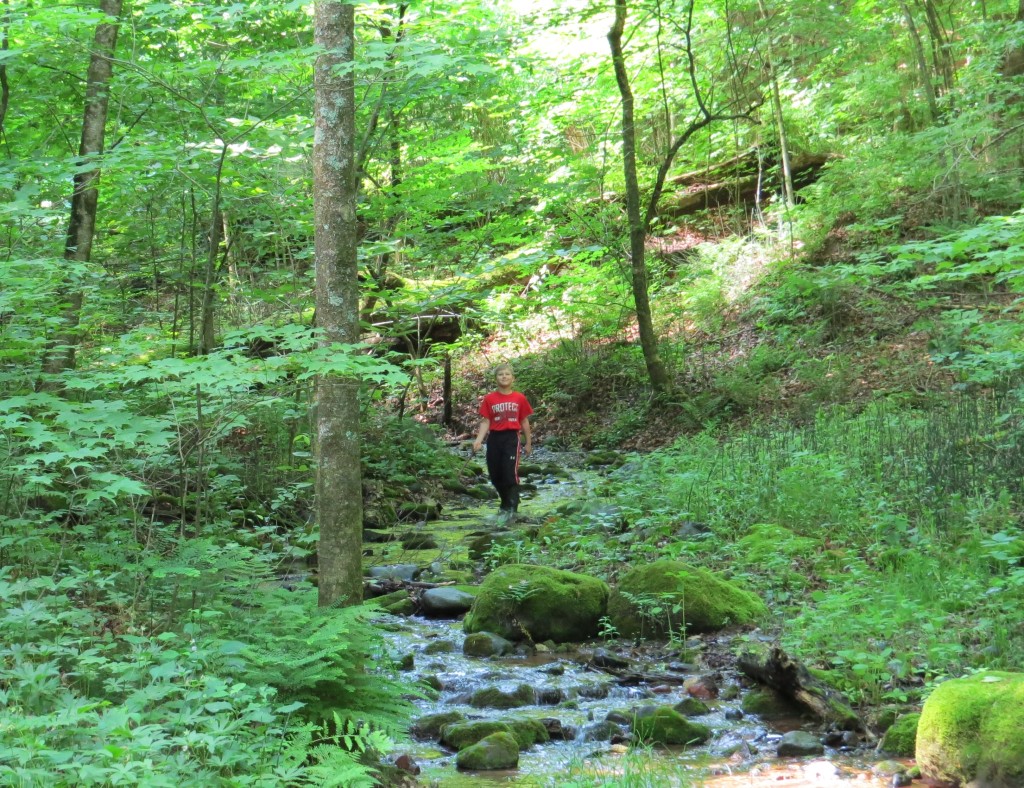 Another lifer for Tommy that we both enjoyed up close was the Veery.
Another lifer for Tommy that we both enjoyed up close was the Veery.
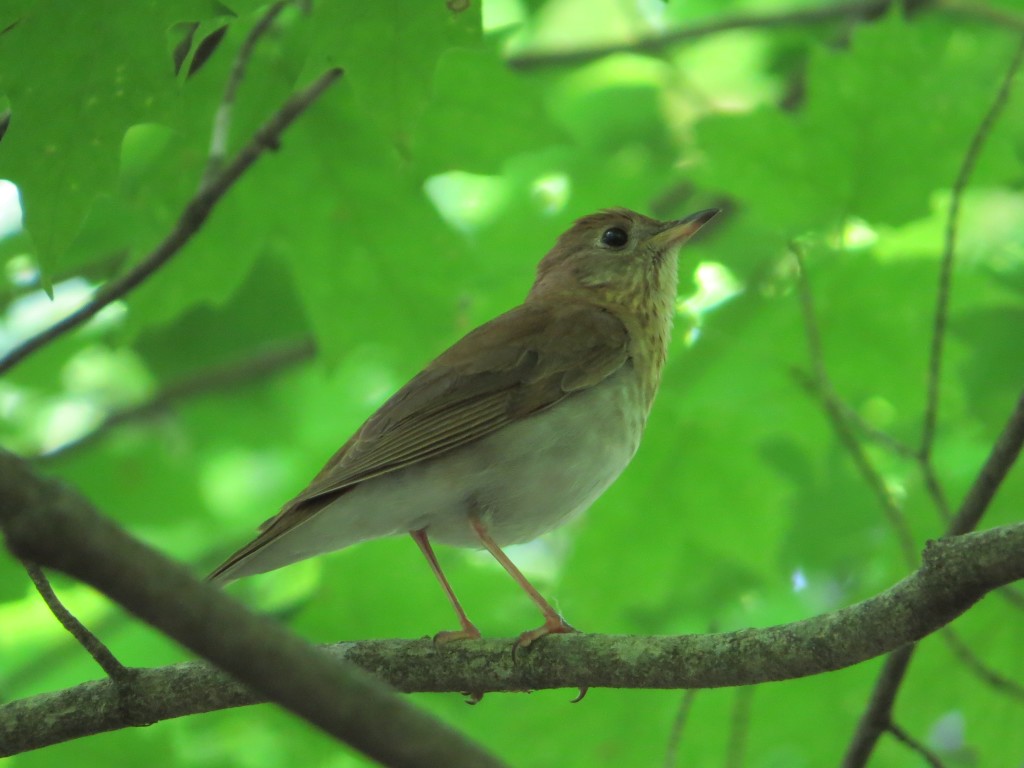 The Veery’s song is the best. It’s unmistakable song can often be heard throughout the deciduous woods of Minnesota. Never before I had I actually seen one sing.
The Veery’s song is the best. It’s unmistakable song can often be heard throughout the deciduous woods of Minnesota. Never before I had I actually seen one sing.
Tommy and I thoroughly enjoyed this stop at Falls Creek SNA. It is truly one of Minnesota’s birding gems that deserves its rightful place alongside places like Felton Prairie, Blue Mounds State Park, Sax-Zim Bog, etc. There were so many good species to be had. At one point I could hear Louisiana Waterthrush, Acadian Flycatcher, and Pine Warblers all at once, not to mention the sounds of Veery, Wood Thrush, and Scarlet Tanager not too far away. This place is a must stop for any serious Minnesota birder. Or herper. This 4-foot Fox Snake was in the parking lot on the way out and put on its best rattlesnake impression, frantically wiggling its rattle-less tail.
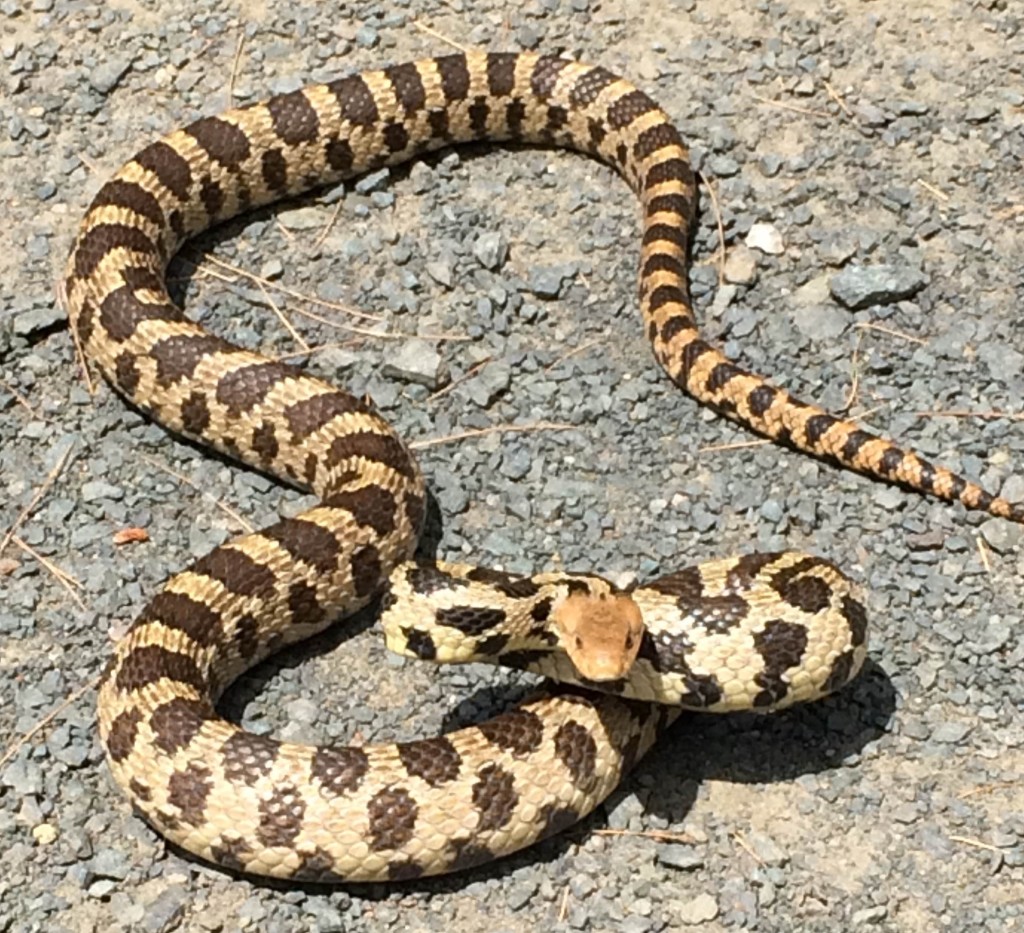 Coming up is one more Minnesota post with Tommy about a rare Warbler we went after for Tommy’s life list. And then we will cover our side trip to Wisconsin to search for two endangered species. Stay tuned.
Coming up is one more Minnesota post with Tommy about a rare Warbler we went after for Tommy’s life list. And then we will cover our side trip to Wisconsin to search for two endangered species. Stay tuned.
Louisiana Waterthrush
Acadian Flycatcher
Arctic Tern
A Tern for the Better
Apologies for the overused pun here, but it truly is fitting. And apologies on further delaying reports from the Tommy D trip in order to cover an outing that happened after his departure, but there has been a tern of events. Apologies again.
I really hate &*%$ Terns. I am, of course, still licking the wounds from the Gull-billed saga that you just read about, but newer readers may not know about that other horrible, awful, no-good, rotten Least Tern chase to Luverne two years ago. Not only did we miss the bird by 15 minutes and see Randy get that one minutes before us just like he did with GBTE, but then there was the accompanying camping trip that put Murphy’s Law to the absolute test. That trip was so miserable, I’m not even going to link to the post on it. Look it up if you want to cringe.
Anyhow, this past Friday I was still recovering from the hardcore birding trip Tommy and I had last week. The Gull-billed Tern fiasco actually seemed like a distant memory because of all Tommy and I experienced together (we’ll get to that, I promise). Then as I was contemplating chasing yet another rarity, a Yelow-breasted Chat, something bumped the Chat in the priority queue: a report of an ARCTIC TERN less than two hours from my house in Big Stone County (the bump on MN’s west side). This was a stunning find by Bob Ekblad who had gone to look for some reported Black-necked Stilts, another casual species in Minnesota.
Despite being burned by two rare Terns in the past, I only hesitated for a moment before throwing the kids in the car and making a run out west. It looks like things finally terned out for me. The Arctic Tern was right where it was reported, resting on the beach of a small wetland. Even from this distant photo, you can see just how short the Arctic Tern’s legs are and how gray its breast is.
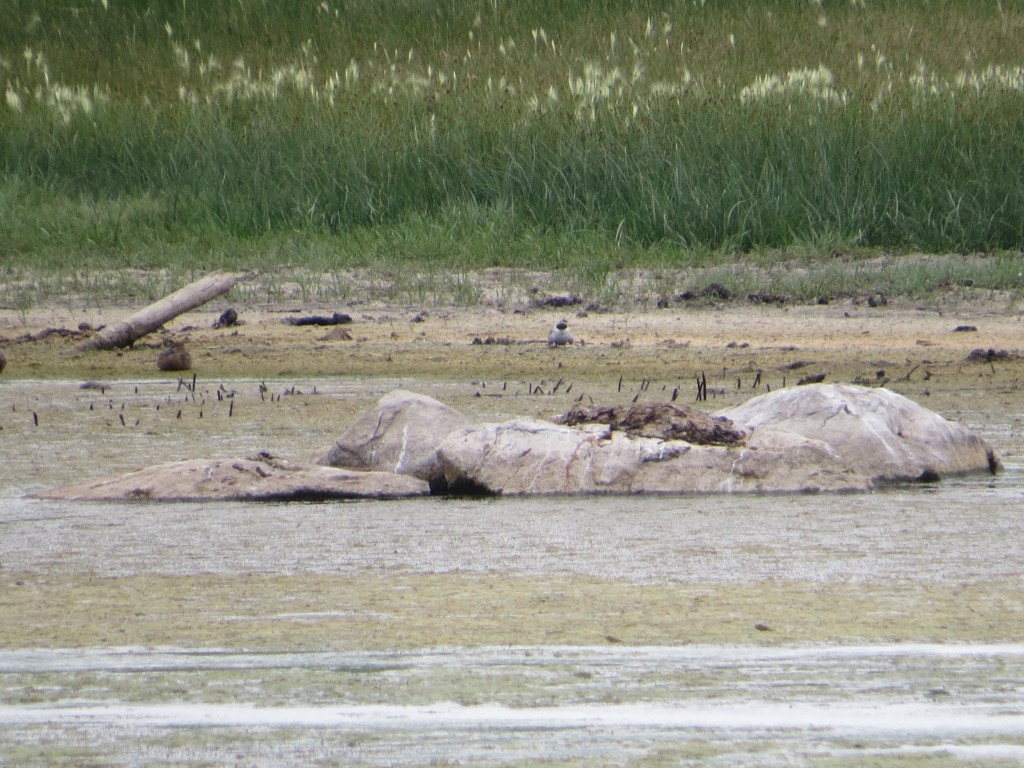 Arctic Tern is casual in Minnesota with most records showing up in Duluth. I never really expected to add this to my life list because A) I’d have to be in Duluth at the right time and B) I’d have to be standing next to an expert birder who could help me differentiate this species from the Common Tern while it flew in the distance.
Arctic Tern is casual in Minnesota with most records showing up in Duluth. I never really expected to add this to my life list because A) I’d have to be in Duluth at the right time and B) I’d have to be standing next to an expert birder who could help me differentiate this species from the Common Tern while it flew in the distance.
So not only was it a thrill to add this unexpected (as in ever) lifer, but there was a driveway to a farm place that put me within 30 feet of the Tern where I could study the field marks for myself up close! Here I could see the stubbier, all red bill compared to the Common Tern’s longer, black-tipped bill. Additionally, I could see the white stripe under the eye and above the gray breast/cheek.
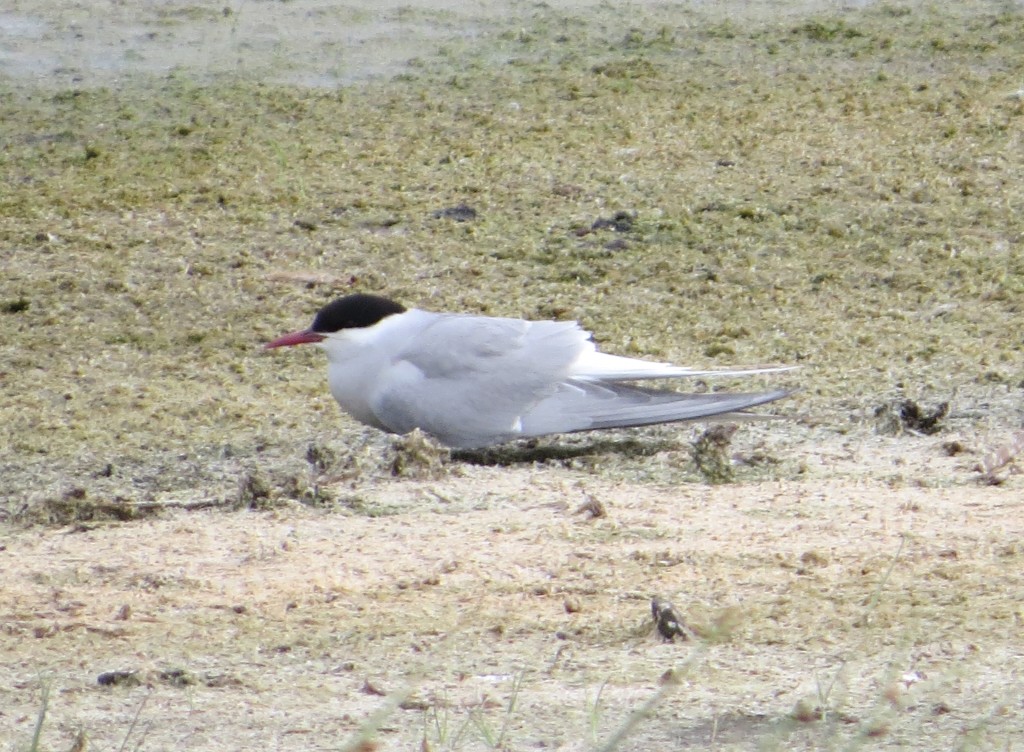 I had thought the Tern was resting on its belly, but I guess its legs are just that short that it only appeared that way. I was hoping to catch the Tern in flight to see the diagnostic dark trailing edge of the primaries. I didn’t get to see it fly, but some other birders did see it fly and captured that field mark in photos. The bird appeared quite lethargic to me, understandable considering the Arctic Tern is famous for its migration from the Antarctic to the Arctic breeding grounds and back each year, a minimum of 24,000 round-trip miles as the crow flies. And we all know Terns don’t fly like Crows. Research with tracking this species has shown that they typically put on 44,000 miles a year. This bird was probably quite wore out and chose the most random of stops to rest.
I had thought the Tern was resting on its belly, but I guess its legs are just that short that it only appeared that way. I was hoping to catch the Tern in flight to see the diagnostic dark trailing edge of the primaries. I didn’t get to see it fly, but some other birders did see it fly and captured that field mark in photos. The bird appeared quite lethargic to me, understandable considering the Arctic Tern is famous for its migration from the Antarctic to the Arctic breeding grounds and back each year, a minimum of 24,000 round-trip miles as the crow flies. And we all know Terns don’t fly like Crows. Research with tracking this species has shown that they typically put on 44,000 miles a year. This bird was probably quite wore out and chose the most random of stops to rest.
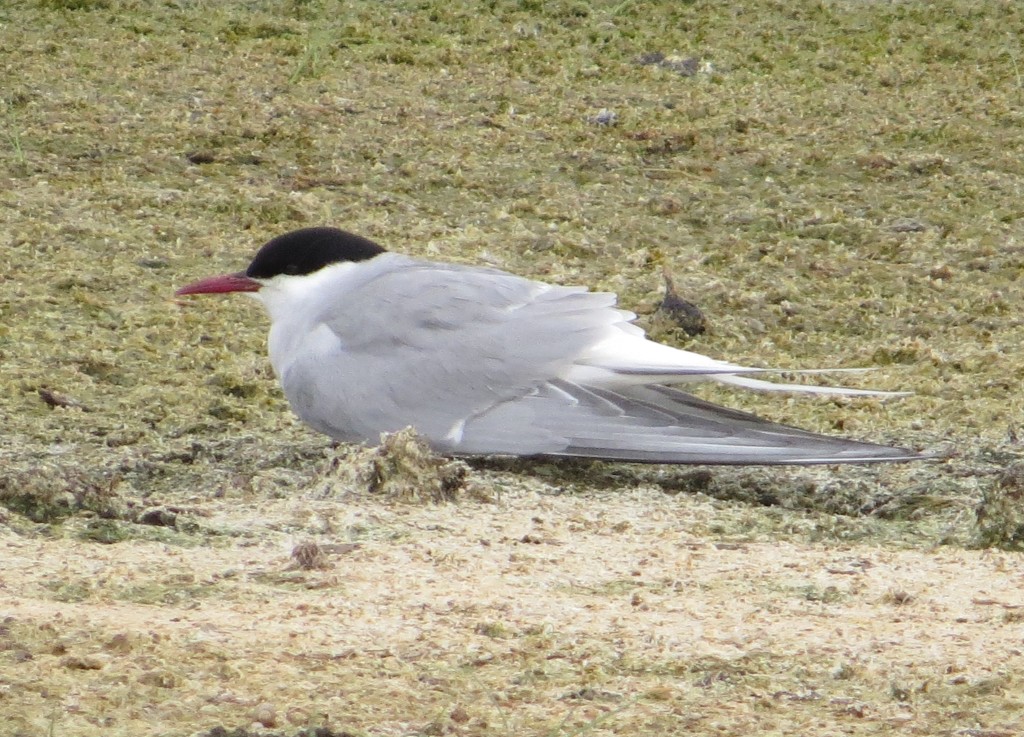 Keeping the Tern company was an American Avocet which is not that rare of bird this far west in Minnesota. Avocets have almost become something of a trash bird on this blog this year. Who would’ve thought?
Keeping the Tern company was an American Avocet which is not that rare of bird this far west in Minnesota. Avocets have almost become something of a trash bird on this blog this year. Who would’ve thought?
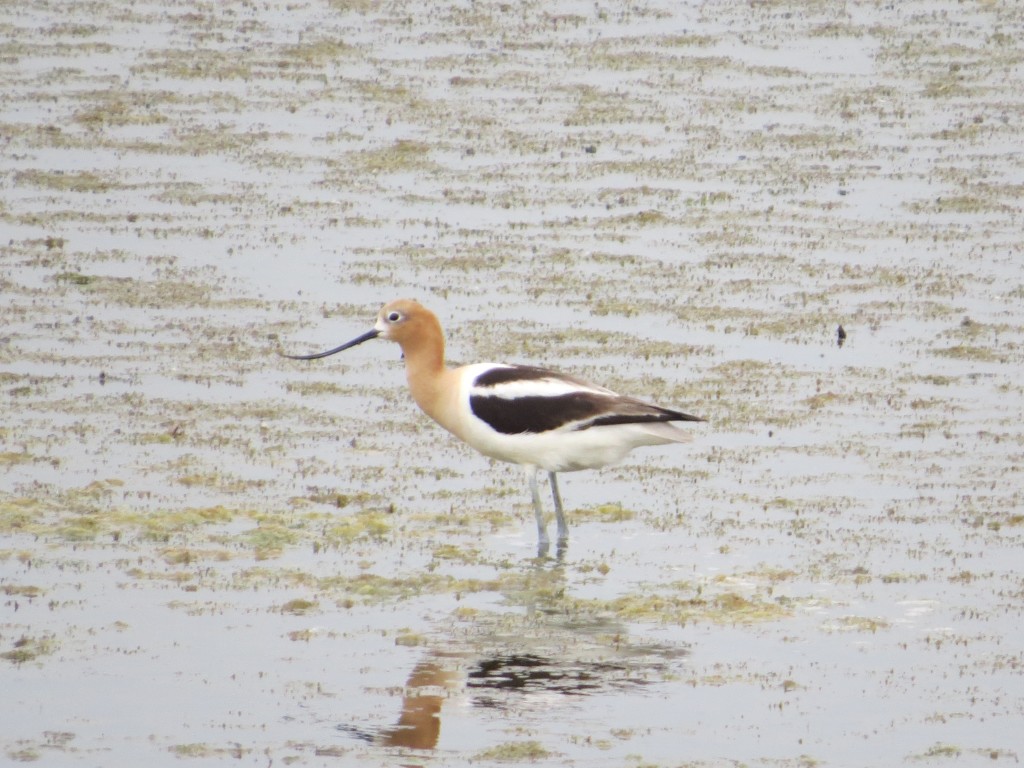 Since the Black-necked Stilts are a good bird for MN and since they had been relocated while I was on my way to the Tern, I decided to check up on them too. The Stilts would not even be a state bird, but I won’t pass up a chance to see some easy ones that are nearby. They are still quite revered here and have not attained the trash nickname of ‘Mud Poodles’ as they have in some other states.
Since the Black-necked Stilts are a good bird for MN and since they had been relocated while I was on my way to the Tern, I decided to check up on them too. The Stilts would not even be a state bird, but I won’t pass up a chance to see some easy ones that are nearby. They are still quite revered here and have not attained the trash nickname of ‘Mud Poodles’ as they have in some other states.
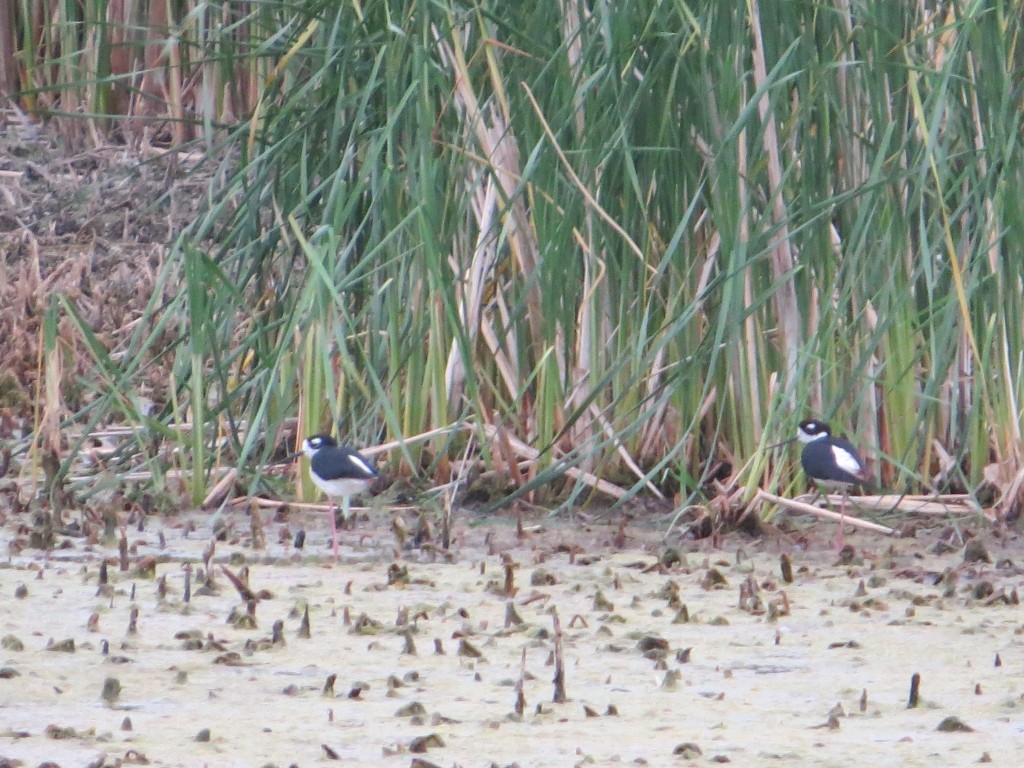 Three great birds, two of which were casual species and one of which was a lifer, made for a great day of birding. Terns out I made the right decision to chase when I did. Unfortunately for Randy and Steve, they were not able to relocate either the Arctic Tern or the Black-necked Stilts the next day.
Three great birds, two of which were casual species and one of which was a lifer, made for a great day of birding. Terns out I made the right decision to chase when I did. Unfortunately for Randy and Steve, they were not able to relocate either the Arctic Tern or the Black-necked Stilts the next day.
I still hate Terns, just slightly less so than I did before. The urge to swear when talking about them is gone. Also, I hate Chats now too.
